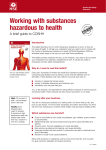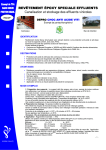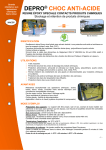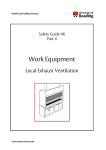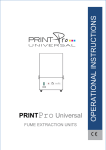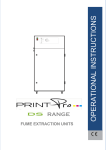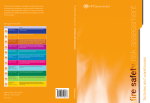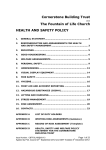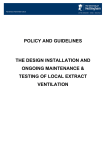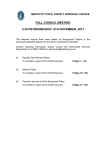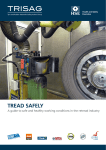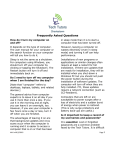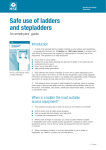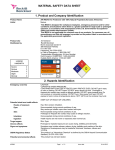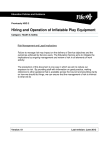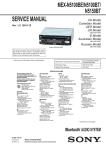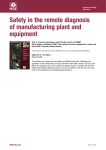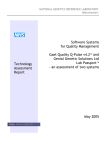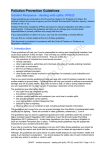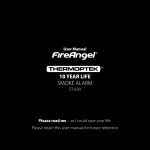Download Feather Flickers COSHH Manual
Transcript
Health and Safety Executive Working with substances hazardous to health What you need to know about COSHH Introduction This leaflet describes how to control hazardous substances at work so that they do not cause ill health. It will help you understand what you need to do to comply with the Control of Substances Hazardous to Health (COSHH) Regulations 2002 (as amended) which apply to the way you work with these substances. If you run a small business or are self-employed, you need this information to make sure you are protecting your employees. If you run a medium-sized or large business, where decisions about controlling hazardous substances are more complex, you will also need professional advice. The leaflet will also be useful for trade union and employee health and safety representatives. This is a web-friendly version of leaflet INDG136(rev4), revised 06/09 Why do I need to read this leaflet? Every year, thousands of workers are made ill by hazardous substances, contracting lung disease such as asthma, cancer and skin disease such as dermatitis. These diseases cost many millions of pounds each year to: Q Q Q industry, to replace the trained worker; society, in disability allowances and medicines; and individuals, who may lose their jobs. You, as the employer, are responsible for taking effective measures to control exposure and protect health. These measures can also improve production or cut waste. Looking after your business Myth ‘Of course it’s safe – we’ve always done it this way.’ Your aim in running your business is to make a profit. You know what you do, and how you are doing it. You know what ‘processes’ and ‘tasks’ are involved. You know the short cuts. Ensuring your workers remain healthy may also lead to healthy profits. Which substances are harmful? Reality Some diseases take years to develop. If exposure is high because the task has always been done that way, maybe it’s time for a change. Q Q Q Q Q Dusty or fume-laden air can cause lung diseases, eg in welders, quarry workers or woodworkers. Metalworking fluids can grow bacteria and fungi which cause dermatitis and asthma. Flowers, bulbs, fruit and vegetables can cause dermatitis. Wet working, eg catering and cleaning, can cause dermatitis. Benzene in crude oil can cause leukaemia. 1 of 10 pages Health and Safety Executive Myth ‘It’s natural so it can’t be harmful.’ Many other products or substances used at work can be harmful, such as paint, ink, glue, lubricant, detergent and beauty products. Reality Natural materials can be harmful. For example, henna can cause dermatitis and asthma, wood dust can cause asthma, stone or concrete dust can cause lung disease such as silicosis, and citrus oils can cause skin problems. Ill health caused by these substances used at work is preventable. Many substances can harm health but, used properly, they almost never do. Find out the dangers in your business – ask your supplier, your trade association, and check for your trade on HSE’s website: www.hse.gov.uk. Substances can also have dangerous properties. They may be flammable, for example solvent-based products may give off flammable vapour. Clouds of dust from everyday materials, such as wood dust or flour, can explode if ignited. This leaflet does not deal with flammability or explosion hazards (see ‘Find out more’). Look at each substance Which substances are involved? In what way are they harmful? You can find out by: Q Q Q Q checking information that came with the product, eg a safety data sheet; asking the supplier, sales representative and your trade association; looking in the trade press for health and safety information; checking on the Internet, eg HSE’s website pages for your trade. Think about the task If the substance is harmful, how might workers be exposed? Q Q Q Q Q Breathing in gases, fumes, mist or dust? Contact with the skin? Swallowing? Contact with the eyes? Skin puncture? Bear these in mind when you look at the tasks. Exposure by breathing in Once breathed in, some substances can attack the nose, throat or lungs while others get into the body through the lungs and harm other parts of the body, eg the liver. Exposure by skin contact Some substances damage skin, while others pass through it and damage other parts of the body. Skin gets contaminated: Myth ‘I don’t work with harmful substances.’ Reality Most businesses use substances that can be hazardous to health – even something as simple as flour can act as a substance hazardous to health. Q Q Q Q by direct contact with the substance, eg if you touch it or dip your hands in it; by splashing; by substances landing on the skin, eg airborne dust; by contact with contaminated surfaces – this includes contact with contamination inside protective gloves. Exposure by swallowing People transfer chemicals from their hands to their mouths by eating, smoking etc without washing first. Exposure to the eyes Some vapours, gases and dusts are irritating to eyes. Caustic fluid splashes can damage eyesight permanently. Exposure by skin puncture Risks from skin puncture such as butchery or needlestick injuries are rare, but can involve infections or very harmful substances, eg drugs. Working with substances hazardous to health 2 of 10 pages Health and Safety Executive Safety data sheets Products you use may be ‘dangerous for supply’. If so, they will have a label that has one or more hazard symbols. S European symbols T+ i Toxic Very toxic Harmful Irritant Explosive Dangerous to the environment F+ Highly flammable Extremely flammable Oxidising Corrosive These products include common substances in everyday use such as paint, bleach, solvent or fillers. When a product is ‘dangerous for supply’, by law, the supplier must provide you with a safety data sheet. Note: medicines, pesticides and cosmetic products have different legislation and don’t have a safety data sheet. Ask the supplier how the product can be used safely. Safety data sheets can be hard to understand, with little information on measures for control. However, to find out about health risks and emergency situations, concentrate on: New International symbols Part 15 of the sheet, which tells you what the dangers are; Q Parts 4 to 8, which tell you about emergencies, storage and handling. Q International symbols will replace the European symbols in 2009. Some of them are similar to the European symbols but there is no single word describing the hazard. Read the hazard statement on the packaging and the safety data sheet from the supplier. Assessing risk Hazard checklist Does any product you use have a danger label? Does your process produce gas, fume, dust, mist or vapour? Is the substance harmful to breathe in? Can the substance harm your skin? Is it likely that harm could arise because of the way you use or produce it? What are you going to do about it? – Use something else? – Use it in another, safer way? – Control it to stop harm being caused? Risk assessment is not just a paper exercise. It’s about taking sensible steps to prevent ill health. You need to know how workers are exposed, and to how much, before you can decide if you need to do anything to reduce their exposure. The COSHH Regulations require employers to assess the risk to their employees, and to prevent or adequately control those risks. Sometimes, it’s easy to judge the amount of exposure to substances and decide what you can do about it. When the task involves very small amounts of material, even if these are harmful, when there is little chance of it escaping, the risk is low. But the risk in a different task – such as cleaning up and disposal – will be higher because the harmful substance may be breathed in or get onto the skin. When the task involves larger amounts of material, with obvious leaks, exposure is higher and so is the risk. Whether the substance is harmful or not, your need to control it is obvious. Decide what measures you need to take, and when. Working with substances hazardous to health 3 of 10 pages Health and Safety Executive Myth ‘What do you expect – it’s a dirty job!’ Reality Why does your job need to be dirty? Think about changing the way you work to produce cleaner processes. If you have five or more employees, you must record your assessment but, even if you have fewer than five, it makes sense to write down what steps you have taken to identify the risks. And the really important part is making a list of the actions you are taking to control the risks to health. You can look at examples of risk assessments for different industries on www.hse.gov.uk/risk/casestudies. HSE has developed a free internet tool for identifying good control practice: www.coshh-essentials.org.uk. It covers a wide range of processes and activities and also produces advice for products that have safety data sheets. However, there may be no ‘good practice’ advice available for your process. Where this is small-scale with obvious control measures, you can do the assessment yourself. In other cases, or where you are not sure, ask your supplier, trade association, HSE’s Infoline, or other reliable information sources. You may need professional advice such as from an occupational hygienist – see ‘Getting help’. What are exposure control measures? Control measures are always a mixture of equipment and ways of working to reduce exposure. The right combination is crucial. No measures, however practical, can work unless they are used properly. So any ‘standard operating procedure’ should combine the right equipment with the right way of working. This means instructing, training and supervising the workers doing the tasks. You need control measures that work and continue to work – all day, every day. Examples of control measures Substance, process Control equipment Q Cleaning with Q Use a rag holder. solvent on rag. Q Provide a small bin with a lid for used rags. Q Dust and sparks from abrasive wheel. Q Fume from Way of working Managing Q Avoid skin contact. Q Reduce solvent vapour from Q Check controls are used rags. used. Q Safe disposal. Q Put an enclosure Q Check the airflow indicator. Q Maintain controls. around the wheel Q Make sure the extraction works. Q Test controls as required and extract the air by law. to a safe place. Q Work outdoors upwind of the helmet, gloves. fume wherever possible. Q Washing facilities. Q Allow the fume to clear before removing helmet. Q Check if there is any Q Cutting-fluid Q Put an enclosure mist from a lathe. Q Swarf. around the lathe and extract the air to a safe place. Q Protective gloves. Q Train workers. Q Check and maintain cutting demolition scrap. Q Ventilated welding Q Use skin-care products. Q Make sure the extraction works. Q Allow time for the mist to clear from the enclosure before opening it. lead paint on the scrap being cut. Q Carry out health checks. fluid quality. Q Test controls as required by law. Q Carry out health checks. Q Dust from disc cutter on stone worktop. Q Use an enclosure Q Cut and polish worktops inside Q Test and maintain to extract air to a safe place. Q High-efficiency vacuum cleaner. an enclosure. Q Vacuum up dust. Q Carry out health checks. Working with substances hazardous to health controls. 4 of 10 pages Health and Safety Executive Choosing control measures Myth ‘They wouldn’t sell it to us if it wasn’t safe.’ Reality Just because something is available to buy, does not mean it is safe – you can buy cyanide for industrial use. In order of priority: 1 2 3 4 5 6 7 Eliminate the use of a harmful product or substance and use a safer one. Use a safer form of the product, eg paste rather than powder. Change the process to emit less of the substance. Enclose the process so that the product does not escape. Extract emissions of the substance near the source. Have as few workers in harm’s way as possible. Provide personal protective equipment (PPE) such as gloves, coveralls and a respirator. PPE must fit the wearer. If your control measures include 5, 6 and 7, make sure they all work together. Control equipment Control equipment comes in many forms. It includes ventilation to extract dust, mist and fume; glove boxes and fume cupboards; spray booths and refuges (clean rooms in dirty work areas). It also includes using water to reduce dust, and systems for disinfecting cooling water. For control equipment, your supplier should provide a ‘user manual’. If you don’t have one, ask for it. And if this is impossible, you may need professional help to write one. The user manual should set out schedules for checks, maintenance and parts replacement. For example it should include: Q Q Q Q Q Q Q a description of the system; the daily checks the worker or supervisor needs to carry out, eg the ventilation is turned on, the airflow meter gives the right reading; the weekly or monthly checks the supervisor or owner needs to carry out, eg of equipment wear and tear, and that short cuts are not creating dangers; details of any thorough examination and test; signs of wear and control failure; a list of replaceable parts; a description of how operators should use the system so it works effectively. Remedy defects in good time. It is pointless making checks if you take no action when something is wrong. And you are not managing health and safety properly if the ‘thorough examination and test’ produces a long list of ‘actions needed’. Keep simple records of your checks and actions, eg in a logbook, and keep these records for at least five years. Staying in control: checking and maintaining Once you’ve got control you need to keep it. As the employer, you must make sure that the control measures (equipment and the way of working) keep working properly. You should name someone to be in charge of checking and maintaining control measures. It could be you, or someone you appoint, as long as they know what they need to do, and are able to do it. That is, they are ‘competent’ to: Q Q Q check that the process isn’t emitting uncontrolled contaminants; check that the control equipment continues to work as it was designed; check that workers follow the right way of working. Working with substances hazardous to health 5 of 10 pages Health and Safety Executive Myth ‘I’ve given them all masks – problem solved!’ Reality This won’t solve it. Control the source of exposure and then they might not need masks. Two of the most common control measures where maintenance is critical are local exhaust ventilation (LEV) and personal protective equipment (PPE). Local exhaust ventilation (LEV) If you use local exhaust ventilation to control exposure, it needs regular checking and thorough examination and testing at least once a year. Many people, eg engineers or insurance companies can carry out thorough examination and testing of LEV. Whoever does the work must be competent – see ‘Getting help’. Personal protective equipment (PPE) Personal protective equipment is often used as part of control measures. This also needs checking and maintenance because, if it fails, it no longer provides protection and exposes the wearer to danger. The users need to know exactly what they are doing, and so do the supervisors. PPE suppliers, trade associations and HSE Infoline can tell you about training in how to use it properly. See ‘Getting help’ and ‘Further information’. Checklist for good control practice Do you design and run your processes to keep the spread of contaminants as low as possible? Do you think about all routes of exposure – breathing in, on skin or swallowing? Do you choose control measures according to the amount of substance, how it gets into the body and how much harm it will cause? Do you make sure that measures are effective, easy to use, and work properly? Do you also need to issue personal protective equipment (PPE)? Do you check regularly that measures continue to work, and keep simple records? Do you tell workers about the dangers and how to use control measures properly? Do you avoid increasing the overall health and safety risks when making changes? Skills and experience Competence Ensure that whoever designs, installs, maintains and tests your control measures is competent – they have the necessary skills, knowledge and experience. You can assess the competence of equipment and service providers with questions such as: Q Q Q Q Have you done this sort of work before? What are your qualifications? Do you belong to a professional organisation? Can I speak to previous clients? Ideally, you want someone who knows your industry, has a successful track record, and gives good value for money. Working with substances hazardous to health 6 of 10 pages Health and Safety Executive Worker involvement Involve your workers in developing control measures to make sure they are suitable for the way they carry out the work. Encourage them to suggest improvements, and to report anything they think might be going wrong. Training, instruction and information Q Explain to your workers, and anyone else who needs to know, what the dangers are. It is poor practice just to hand them a page of written information. Q Show workers how to use control measures properly, and how to check that they are working. Q Carry out practice drills for cleaning up spills safely – do this before any spillages happen. Q If workers need to use respirators, they also need face fitting and training. Q If they need to use protective gloves, they need to know how to put them on and take them off without contaminating their skin. See ‘Find out more’. Keeping workers healthy Monitoring exposure Monitoring normally means air sampling but it may also involve taking biological samples, eg breath or urine. Monitoring normally makes reference to ‘Workplace Exposure Limits’ (WELs) published by HSE. These limits should not be exceeded (see EH40 in ‘Find out more’). It is wasteful to try monitoring before you have put any control measures in place (see COSHH essentials sheet G409 www.hse.gov.uk/pubns/guidance/g409.pdf on air monitoring). Health checks If your trade press, HSE, or other information, shows there is a problem with health in your trade, such as asthma or dermatitis, your employees may need special health checks. The most common checks are for respiratory disease such as asthma and skin disease. See ‘Find out more’. REACH REACH is a new European Union regulation concerning the Registration, Evaluation, Authorisation and restriction of CHemicals. It came into force on 1 June 2007 and replaces a number of European Directives and Regulations with a single system. REACH will operate alongside COSHH and is designed so that better information on the hazards of chemicals and how to use them safely will be passed down the supply chain by chemical manufacturers and importers through improved safety data sheets. Further information can be found on HSE’s website: www.hse.gov.uk/ reach/ and on the European Chemical Agency’s website: www.echa. europa.eu/home_en.asp. Working with substances hazardous to health 7 of 10 pages Health and Safety Executive Getting help Trade association HSE Consultants/service suppliers Local health and safety groups Good control Testing LEV Training Monitoring Health checks What and who? This is not an inclusive list, but some useful sources of information and help are: Q British Occupational Hygiene Society (BOHS) 5/6 Melbourne Business Court, Millennium Way, Pride Park, Derby, DE24 8LZ. Tel: 01332 298101 www.bohs.org. BOHS is the professional body for occupational hygienists, who understand how workplace hazards affect worker health and systems to control risks to health from work. The website has a list of consultants. Q Health & Safety Laboratory (HSL) Business Development Group, Health & Safety Laboratory, Harpur Hill, Buxton, Derbyshire SK17 9JN. Tel: 01298 218000 www.hsl.gov.uk. HSL’s services include specialist advice and consultancy, risk assessment, and workplace monitoring (including biological monitoring). Q Institution of Occupational Safety and Health (IOSH) The Grange, Highfield Drive, Wigston, Leicestershire LE18 1NN. Tel: 0116 257 3100 www.iosh.co.uk. IOSH is the association for health and safety professionals. The website allows you to search for consultants. United Kingdom Accreditation Service (UKAS) 21-47 High Street, Feltham, Middlesex TW13 4UN. Tel: 020 89178400 www.ukas.com. The UKAS website has a search function to find accredited testing and inspection service providers. Q Trade associations Health and safety information is often produced by trade associations and published in the trade press. Q Occupational health professionals (doctors or nurses) Look in Yellow Pages or other trade indexes for occupational health under ‘Health and Safety Consultants’ or ‘Health Authorities and Services’, or visit www.nhsplus.nhs.uk. Q Safety Groups UK (SGUK) Edgbaston Park, 353 Bristol Road, Edgbaston, Birmingham B5 7ST Tel: 0121 248 2011 www.safetygroupsuk.org.uk Working with substances hazardous to health 8 of 10 pages Health and Safety Executive Find out more A short guide to the Personal Protective Equipment at Work Regulations 1992 Leaflet INDG174(rev1) HSE Books 2005 (single copy free or priced packs of 15 ISBN 978 0 7176 6141 1) www.hse.gov.uk/pubns/indg174.pdf Clearing the air: A simple guide to buying and using local exhaust ventilation (LEV) Leaflet INDG408 HSE Books 2008 (single copy free or priced packs of 15 ISBN 978 0 7176 6301 9) EH40/2005 Workplace exposure limits: Containing the list of workplace exposure limits for use with the Control of Substances Hazardous to Health Regulations 2002 (as amended) Environmental Hygiene Guidance Note EH40 HSE Books 2005 ISBN 978 0 7176 2977 0 Fire and explosion: How safe is your workplace? A short guide to the Dangerous Substances and Explosive Atmospheres Regulations Leaflet INDG370 HSE Books 2002 (single copy free or priced packs of 5 ISBN 978 0 7176 2589 5) www.hse.gov.uk/pubns/indg370.pdf Preventing contact dermatitis at work Leaflet INDG233(rev1) HSE Books 2007 (single copy free or priced packs of 15 ISBN 978 0 7176 6183 1) www.hse.gov.uk/pubns/indg233.pdf Read the label: How to find out if chemicals are dangerous Leaflet INDG352 HSE Books 2002 (single copy free or priced packs of 15 ISBN 978 0 7176 2366 2) www.hse.gov.uk/pubns/indg352.pdf Respiratory sensitisers and COSHH: Breathe freely – An employers’ leaflet on preventing occupational asthma Leaflet INDG95(rev2) HSE Books 1995 (single copy free or priced packs of 15 ISBN 978 0 7176 0914 7) www.hse.gov.uk/pubns/ indg95.pdf Working with substances hazardous to health 9 of 10 pages Health and Safety Executive Further information HSE priced and free publications are available by mail order from HSE Books, PO Box 1999, Sudbury, Suffolk CO10 2WA Tel: 01787 881165 Fax: 01787 313995 Website: www.hsebooks.co.uk (HSE priced publications are also available from bookshops and free leaflets can be downloaded from HSE’s website: www.hse.gov.uk.) For information about health and safety ring HSE’s Infoline Tel: 0845 345 0055 Fax: 0845 408 9566 Textphone: 0845 408 9577 e-mail: [email protected] or write to HSE Information Services, Caerphilly Business Park, Caerphilly CF83 3GG. This leaflet contains notes on good practice which are not compulsory but which you may find helpful in considering what you need to do. This leaflet is available in priced packs of 10 from HSE Books, ISBN 978 0 7176 6363 7. Single free copies are also available from HSE Books. © Crown copyright This publication may be freely reproduced, except for advertising, endorsement or commercial purposes. First published 06/09. Please acknowledge the source as HSE Published by the Health and Safety Executive INDG136(rev4) 10 of 10 pages COSHH and cleaners - key messages Page 1 of 1 COSHH and cleaners - key messages • Having your hands wet for a long time or having them frequently wet during the day can irritate your skin leading to dermatitis. • Some ingredients in cleaning products can cause skin allergies and asthma. • Some cleaning products are corrosive and can cause skin burns and eye damage. There are simple things you can do to prevent ill health. Preventing exposure to harmful substances usually means a combination of some of the following controls: • Use good work techniques that avoid or minimise contact with harmful substances and minimise leaks and spills. Store cleaning products safely. • For some tasks, you may also need to provide personal protective equipment like protective gloves, aprons and eye protection. • Practice good hand care – remove contamination promptly, wash hands properly, dry thoroughly and use skin creams regularly. • Keep the workplace well ventilated. The controls you need will depend on the task. Click the links below for more specific information. • SR24 Storing chemical products (small scale). [30.7KB] • SR2 Diluting chemical concentrates. [37.8KB] [1] [2] • SR4 Manual cleaning and disinfecting surfaces. [129KB] [3] • SR1 Cleaning & disinfection with low pressure washers. [41.2KB] [4] Link URLs in this page 1. SR24 Storing chemical products (small scale). [30.7KB] http://www.coshh-essentials.org.uk/assets/live/SR24.pdf 2. SR2 Diluting chemical concentrates. [37.8KB] http://www.coshh-essentials.org.uk/assets/live/SR02.pdf 3. SR4 Manual cleaning and disinfecting surfaces. [129KB] http://www.coshh-essentials.org.uk/assets/live/SR04.pdf 4. SR1 Cleaning & disinfection with low pressure washers. [41.2KB] http://www.coshh-essentials.org.uk/assets/live/SR01.pdf http://www.hse.gov.uk/coshh/industry/cleaning.htm 25/01/2010 Health and Safety Executive Preventing contact dermatitis at work Health and Safety Executive Preventing contact dermatitis at work This leaflet tells you about a skin problem that you can get at work – contact dermatitis. If you are an employer, safety representative, trainer or safety advisor you can influence work practice and prevent this disabling disease. The leaflet shows you what to look out for and how to prevent dermatitis. It also tells you where you can find more detailed practical advice for specific jobs and workplaces. What is contact dermatitis? This is a web-friendly version of leaflet INDG233(rev1), revised 03/07 Contact dermatitis is inflammation of the skin caused by contact with a range of materials. These include detergents, toiletries, chemicals and even natural products like foods and water (if contact is prolonged or frequent). It can affect all parts of the body, but it is most common to see the hands affected. There are three main types of contact dermatitis: I I I irritant contact dermatitis: allergic contact dermatitis: contact urticaria. Irritant contact dermatitis is caused by things that dry out and damage the skin, eg detergents, solvents, oils and prolonged or frequent contact with water. Allergic contact dermatitis occurs when someone becomes allergic to something that comes into contact with his or her skin. The allergic reaction can show up hours or days after contact. Common causes include chemicals in cement, hair products, epoxy resins and some foods. Urticaria is a different kind of allergy. It occurs within minutes of the material touching the skin. Things like plants, foods and natural rubber latex gloves can cause it. What does contact dermatitis look like? The signs and symptoms of the different types of dermatitis are similar. Dry, red and itchy skin is usually the first sign. Swelling, flaking, blistering, cracking and pain can follow. Sometimes the consequences of contact with a material are immediately visible. Sometimes contact occurs without apparent effect. However, every contact can cause minute amounts of ‘invisible’ damage to the skin that can build up until more serious signs are seen. So, don’t be lulled into a false sense of security. 1 of 3 pages Health and Safety Executive What are the high-risk jobs and workplaces? Certain workers are at greater risk of developing dermatitis. They include healthcare workers, hairdressers, beauticians, printers, those in cleaning, catering and construction and workers using metalworking fluids. But remember, dermatitis can occur in just about any workplace. Managing the work to prevent dermatitis Following three simple steps can prevent dermatitis: Avoid contact with materials that cause dermatitis. Protect the skin. Check for early signs of dermatitis. No contact = no dermatitis. So take all the steps you can to avoid contact with materials that cause dermatitis by changing the task or process. Some examples of how you can do this are given below. Examples of how you can avoid contact are: I I I I I I I substitute a more hazardous material with a safer alternative; automate the process; enclose the process as much as possible; use mechanical handling; use equipment for handling; don’t use the hands as tools; use a safe working distance. You will also need to protect the skin. This is particularly important if the steps above aren’t practical or aren’t enough to totally avoid contact. You can protect the skin by the following: I I I I I I I I I I tell workers how to look after their skin; remind them to wash any contamination from their skin promptly; tell them about the importance of thorough drying after washing; provide soft cotton or paper towels; supply moisturising pre-work and after-work creams; provide appropriate protective clothing/gloves; make sure gloves are made of suitable material; select gloves that are the right size and right for the task to be done; use and store gloves correctly; replace gloves when necessary. You will also need to make sure regular skin checks are carried out to look for early signs of dermatitis. I I I I Regular skin checks can spot the early stages of dermatitis. Early detection can prevent more serious dermatitis from developing. Steps can be taken to start treating the condition. Checks can help indicate a possible lapse in your preventative measures and the need to reassess the situation. Preventing contact dermatitis at work 2 of 3 pages Health and Safety Executive What does the law require? The law requires employers to adequately control exposure to materials in the workplace that cause ill health like dermatitis. Employers and employees need to comply with the Control of Substances Hazardous to Health Regulations 2002 (as amended) (COSHH). They require employers to assess risks, provide adequate control measures, ensure the use and maintenance of these; provide information, instruction and training; and in appropriate cases, health surveillance. Where can I get more detailed information on the topics outlined? Skin disease Skin diseases, preventing skin disease, legislation and other control information: www.hse.gov.uk/skin, www.bsif.co.uk Catering HSE are developing catering web pages during 2007 Construction General construction information: www.hse.gov.uk/construction Hairdressing Good practice advice: www.badhandday.hse.gov.uk Metalworking fluids Good practice advice: www.hse.gov.uk/metalworking/ecoshh Printing Good practice advice: www.hse.gov.uk/printing/dermatitis Further information HSE priced and free publications are available by mail order from HSE Books, PO Box 1999, Sudbury, Suffolk CO10 2WA Tel: 01787 881165 Fax: 01787 313995 Website: www.hsebooks.co.uk (HSE priced publications are also available from bookshops and free leaflets can be downloaded from HSE’s website: www.hse.gov.uk.) For information about health and safety ring HSE’s Infoline Tel: 0845 345 0055 Fax: 0845 408 9566 Textphone: 0845 408 9577 e-mail: [email protected] or write to HSE Information Services, Caerphilly Business Park, Caerphilly CF83 3GG. This leaflet contains notes on good practice which are not compulsory but which you may find helpful in considering what you need to do. This leaflet is available in priced packs of 15 from HSE Books, ISBN 978 0 7176 6183 1. Single copies are free and a web version can be found at: www.hse.gov.uk/pubns/indg233.pdf. © Crown copyright This publication may be freely reproduced, except for advertising, endorsement or commercial purposes. First published 03/07. Please acknowledge the source as HSE. Published by the Health and Safety Executive INDG233(rev1) 3 of 3 pages Health and Safety Executive Diluting chemical concentrates SR2 2 COSHH essentials for service and retail This information will help employers (including the self-employed and franchisees) comply with the Control of Substances Hazardous to Health Regulations 2002 (COSHH), as amended, to control exposure and protect workers’ health. It is also useful for trade union safety representatives. This sheet describes good practice using personal protective equipment (PPE). It covers the points you need to follow to reduce exposure to an adequate level. It is important to follow all the points, or use equally effective measures. Control approach S Harm via skin or eye contact 3 3 Access and premises 3 Equipment 3 3 3 3 Some concentrates are biocidal products. Authorised products are safe for use so long as you follow the instructions on the label. Some chemicals can be flammable, so your controls must suit those hazards too. Look at the safety data sheet for more information. Main points n n n Avoid or minimise skin contact with chemicals. Check that all the controls are being used properly. Consider substituting with safer products. Make sure there is enough room to do the job safely. Provide good washing facilities. Ensure the equipment used with the product works properly, without leaks. Provide protective gloves. If diluting with a solvent, make sure the room is well ventilated; 5-10 changes per hour, with a through draught. Buy liquid chemicals in containers that are easy to pour from, don’t dribble, and don’t trap liquid in a rim. Try to buy solid chemicals in tablet or granule form, or in widenecked containers so it is easy to scoop out. Caution: Never decant concentrate into an unlabelled container. Never re-use a concentrate container - dispose of it safely or return it to your supplier. Don’t store more than 50 litres of flammable liquid indoors- use a flammables store. 3 3 3 3 n n 3 Procedures Contractors using pesticides should have a British Pest Control Association (BPCA) qualification. Store products containing chemicals securely in a cool, dry, dark place, capable of retaining spills. Don’t store far more than you need. Reduce skin contact - workers should wash off splashes immediately. Ensure that workers follow instructions for use by reading the label, and make up solutions for immediate use only. Make sure they are aware of the following general guidelines: Add liquid concentrate to diluting liquid - never the other way round, unless the instructions say so. Make a thin paste of powders with a small amount of diluting liquid, then dilute as for liquids. Put the cap back on the container immediately and wipe the outside clean. Service and retail 3 3 3 3 3 SR2 Harm via skin or eye contact Special care Contact with many chemicals can lead to dermatitis. Some can also damage the eyes. Some products may cause asthma - check the safety data sheet. Avoid products that contain hydrofluoric acid. Take special care using caustic soda (sodium hydroxide). This can erupt when mixed with water. Splashes in the eye can cause blindness. Never add any other chemical to concentrates that contain bleach (sodium hypochlorite solution). This can cause a dangerous gas (chlorine) to be given off. 3 Maintenance, examination and testing 3 3 3 Personal protective equipment (PPE) 3 3 3 3 3 Wash out mixing equipment after use. Dispose of waste liquid safely. Follow the instructions on product labels. Ask your supplier to help you choose the right PPE. Provide protective gloves - single-use nitrile gloves are acceptable. If you must use latex gloves, use only ‘low protein, powder free’ gloves. Throw away single use gloves every time they are taken off. Provide protective goggles to protect eyes when using products that can cause burns (eg acids, caustics). Skin creams are important for skin protection and help in washing contamination from the skin. These are not ‘barrier creams’. After work creams help to replace skin oils. Health monitoring Ask your workers to check their skin for dryness or soreness every six months. If these effects appear, check the proper use of skin creams and PPE. If you use a product labelled ‘may cause sensitisation by skin contact’ or ‘may cause sensitisation by inhalation’, seek specialist advice- See ‘Useful links’. 3 Cleaning and housekeeping 3 Training and supervision 3 3 Clean up spills promptly - practise how to do this. Tell workers about the risks of using the product - see products labels or Section 15 of the safety data sheet. If products can cause skin or eye damage, plan how to give first aid. Working in the right way and using the controls correctly is important for exposure control. Train and supervise workers. See sheet SR0. Service and retail n n n n n n n n SR2 Harm via skin or eye contact Further information Assessing and managing risks at work from skin exposure to chemical agents: Guidance for employers and health and safety specialists HSG205 HSE Books 2001 ISBN 0 7176 1826 9 Hydrofluoric acid poisoning: Recommendations on first aid procedures Leaflet INDG307 HSE Books 1999 (single copy free or priced packs of 25 ISBN 0 7176 1751 3 Web version available at hse.gov.uk/pubns/indg307.pdf) Preventing dermatitis at work: Advice for employers and employees Leaflet INDG233 HSE Books 1996 (single copy free or priced packs of 15 ISBN 0 7176 1246 5) Useful links HSE priced and free publications are available from HSE Books Tel: 01787 881165 Website: www.hsebooks.co.uk. For information about health and safety ring HSE’s Infoline Tel: 0845 345 0055 Textphone: 0845 408 9577 e-mail: [email protected]. Contact the British Occupational Hygiene Society (BOHS) on 01332 298101 or at www.bohs.org for lists of qualified hygienists who can help you. Look in the Yellow Pages under ‘Health and safety consultants’ and ‘Health authorities and services’ for ‘occupational health’. Also see www.nhsplus.nhs.uk. Employee checklist If you find any problems, tell your supervisor. Don’t just carry on working. Use and store your protective equipment according to instructions. Throw away single-use gloves every time you take them off. Wash your hands after use, and before and after eating, drinking, smoking and using the lavatory. Never clean your hands with concentrated cleaning products or solvents. Check your skin regularly for dryness or soreness - tell your supervisor if these symptoms appear. Use skin creams provided as instructed. This guidance is issued by the Health and Safety Executive. Following the guidance is not compulsory and you are free to take other action. But if you do follow the guidance you will normally be doing enough to comply with the law. Health and safety inspectors seek to secure compliance with the law and may refer to this guidance as illustrating good practice. Published by the Health and Safety Executive 06/06 Health and Safety Executive Manual cleaning and disinfecting surfaces SR4 4 COSHH essentials for service and retail Harm via skin or eye contact This information will help employers (including the self-employed and franchisees) comply with the Control of Substances Hazardous to Health Regulations 2002 (COSHH), as amended, to control exposure and protect workers’ health. It is also useful for trade union safety representatives. 3 3 3 3 3 This sheet describes good practice using personal protective equipment (PPE). Disinfectants are biocidal products. Authorised products are safe for use so long as you follow the instructions on the label. Some chemicals can be flammable, so your controls must suit those hazards too. Look at the safety data sheet for more information. Main points n n n n Can you get products ‘ready for use’? Avoid or minimise skin contact with chemicals. Check that all the controls are being used properly. Consider substituting with safer products. Mark any pedestrian routes that can become slippery when wet. Provide good washing facilities. Equipment Do you need colour-coded cloths, mops and buckets to minimise cross-contamination? Provide protective gloves. Remove heavy dirt deposits first. Caution: Never decant concentrate into an unlabelled container. Never re-use a concentrate container - dispose of it safely or return it to your supplier. Don’t store more than 50 litres of flammable liquid It covers the points you need to follow to reduce exposure to an adequate level. It is important to follow all the points, or use equally effective measures. Access and premises indoors - use a flammable store. 3 3 3 3 3 3 Personal protective equipment (PPE) Follow the instructions on product labels. Ask your supplier to help you choose the right PPE. Provide protective gloves - single-use gloves are acceptable. If you must use latex gloves, use only ‘low-protein, powder-free’ gloves. Throw away single-use gloves every time they are taken off. Provide waterproof, slip-resistant footwear. Skin creams are important for skin condition. These help in washing contamination from the skin. After work creams help to replace skin oils. Caution: ‘barrier creams’ do not make a full barrier. 3 3 3 3 Procedures Store products securely in a cool, dry, dark place, capable of keeping in spills. Don’t store far more than you need. Ensure that workers follow the instructions for use by reading the label, and make up solutions for immediate use only. Put the cap back on the container immediately. Keep products off your skin. Workers should wash off any splashes and avoid contact with surfaces until they are dry. Service and retail 3 3 3 3 3 3 SR4 Harm via skin or eye contact Special care Contact with many products can lead to dermatitis. Some can also damage the eyes. Some products may cause asthma - check the safety data sheet. Take special care using caustic soda (sodium hydroxide). Splashes in the eye can cause blindness. Never add any other chemical to concentrates that contain bleach (sodium hypochlorite solution). This can cause a dangerous gas (chlorine) to be given off. Health monitoring Ask your workers to check their skin for dryness or soreness every month. If you use a product labelled ‘may cause sensitisation by skin contact’ or ‘may cause sensitisation by inhalation’, seek specialist advice - see ‘Useful links’. 3 3 Cleaning and housekeeping 3 Training and supervision 3 n n n Wash out the equipment after use. Dispose of this waste liquid safely. Clean up spills promptly - practise how to do this. Tell workers about the risks of using the product - see products labels or Section 15 of the safety data sheet. Working in the right way and using the controls correctly is important for exposure control. Train and supervise workers. See sheet SR0. Further information Assessing and managing risks at work from skin exposure to chemical agents: Guidance for employers and health and safety specialists HSG205 HSE Books 2001 ISBN 0 7176 1826 9 Preventing dermatitis at work: Advice for employers and employees Leaflet INDG233 HSE Books 1996 (single copy free or priced packs of 15 ISBN 0 7176 1246 5) Posters on protective gloves and skin care - see www.hse.gov.uk/skin/information.htm Service and retail n n n n n SR4 Harm via skin or eye contact Useful links HSE priced and free publications are available from HSE Books Tel: 01787 881165 Website: www.hsebooks.co.uk. For information about health and safety ring HSE’s Infoline Tel: 0845 345 0055 Textphone: 0845 408 9577 e-mail: [email protected]. Contact the British Occupational Hygiene Society (BOHS) on 01332 298101 or at www.bohs.org for lists of qualified hygienists who can help you. Look in the Yellow Pages under ‘Health and safety consultants’ and ‘Health authorities and services’ for ‘occupational health’. Also see www.nhsplus.nhs.uk. Employee checklist Look for signs of leaks, wear and damage. If you find any problems, tell your supervisor. Don’t just carry on working. Use and store your protective equipment according to instructions. Throw away single-use gloves every time you take them off. Wash your hands after use. Never clean your hands with concentrated cleaning products or solvents. Check your skin regularly for dryness or soreness - tell your supervisor if these symptoms appear. Use skin creams provided as instructed. This guidance is issued by the Health and Safety Executive. Following the guidance is not compulsory and you are free to take other action. But if you do follow the guidance you will normally be doing enough to comply with the law. Health and safety inspectors seek to secure compliance with the law and may refer to this guidance as illustrating good practice. Published by the Health and Safety Executive 10/06 Health and Safety Executive A short guide to the Personal Protective Equipment at Work Regulations 1992 Health and Safety Executive A short guide to the Personal Protective Equipment at Work Regulations 1992 Employers have basic duties concerning the provision and use of personal protective equipment (PPE) at work and this document, explains what you need to do to meet the requirements of the Personal Protective Equipment at Work Regulations 1992 (as amended). What is PPE? PPE is defined in the Regulations as ‘all equipment (including clothing affording protection against the weather) which is intended to be worn or held by a person at work and which protects him against one or more risks to his health or safety’, eg safety helmets, gloves, eye protection, high-visibility clothing, safety footwear and safety harnesses. This is a web-friendly version of leaflet INDG174(rev1), revised 08/05 Hearing protection and respiratory protective equipment provided for most work situations are not covered by these Regulations because other regulations apply to them. However, these items need to be compatible with any other PPE provided. Cycle helmets or crash helmets worn by employees on the roads are not covered by the Regulations. Motorcycle helmets are legally required for motorcyclists under road traffic legislation. What do the Regulations require? The main requirement of the PPE at Work Regulations 1992 is that personal protective equipment is to be supplied and used at work wherever there are risks to health and safety that cannot be adequately controlled in other ways. The Regulations also require that PPE: ■ ■ ■ ■ is is is is properly assessed before use to ensure it is suitable; maintained and stored properly; provided with instructions on how to use it safely; and used correctly by employees. Can I charge for providing PPE? An employer cannot ask for money from an employee for PPE, whether it is returnable or not. This includes agency workers if they are legally regarded as your employees. If employment has been terminated and the employee keeps the PPE without the employer’s permission, then, as long as it has been made clear in the contract of employment, the employer may be able to deduct the cost of the replacement from any wages owed. 1 of 5 pages Health and Safety Executive Assessing suitable PPE To allow the right type of PPE to be chosen, carefully consider the different hazards in the workplace. This will enable you to assess which types of PPE are suitable to protect against the hazard and for the job to be done. Ask your supplier for advice on the different types of PPE available and how suitable they are for different tasks. It may be necessary in a few particularly difficult cases to obtain advice from specialist sources and from the PPE manufacturer. Another useful source of information is the British Safety Industry Federation (www.bsif.co.uk). Consider the following when assessing whether PPE is suitable: ■ ■ ■ ■ ■ ■ Is it appropriate for the risks involved and the conditions at the place where exposure to the risk may occur? For example, eye protection designed for providing protection against agricultural pesticides will not offer adequate face protection for someone using an angle grinder to cut steel or stone. Does it prevent or adequately control the risks involved without increasing the overall level of risk? Can it be adjusted to fit the wearer correctly? Has the state of health of those who will be wearing it been taken into account? What are the needs of the job and the demands it places on the wearer? For example, the length of time the PPE needs to be worn, the physical effort required to do the job and the requirements for visibility and communication. If more than one item of PPE is being worn, are they compatible? For example, does a particular type of respirator make it difficult to get eye protection to fit properly? The hazards and types of PPE Eyes Hazards: chemical or metal splash, dust, projectiles, gas and vapour, radiation. Options: safety spectacles, goggles, faceshields, visors. Head Hazards: impact from falling or flying objects, risk of head bumping, hair entanglement. Options: a range of helmets and bump caps. Breathing Hazards: dust, vapour, gas, oxygen-deficient atmospheres. Options: disposable filtering facepiece or respirator, half- or full-face respirators, air-fed helmets, breathing apparatus. Protecting the body Hazards: temperature extremes, adverse weather, chemical or metal splash, spray from pressure leaks or spray guns, impact or penetration, contaminated dust, excessive wear or entanglement of own clothing. Options: conventional or disposable overalls, boiler suits, specialist protective clothing, eg chain-mail aprons, high-visibility clothing. Personal Protective Equipment at Work Regulations 1992 2 of 5 pages Health and Safety Executive Hands and arms Hazards: abrasion, temperature extremes, cuts and punctures, impact, chemicals, electric shock, skin infection, disease or contamination. Options: gloves, gauntlets, mitts, wristcuffs, armlets. Feet and legs Hazards: wet, electrostatic build-up, slipping, cuts and punctures, falling objects, metal and chemical splash, abrasion. Options: safety boots and shoes with protective toe caps and penetration-resistant mid-sole, gaiters, leggings, spats. Training ■ ■ ■ ■ Make sure anyone using PPE is aware of why it is needed, when it is to be used, repaired or replaced and its limitations. Train and instruct people how to use it properly and make sure they are doing this. Because PPE is the last resort after other methods of protection have been considered, it is important that users wear it all the time they are exposed to the risk. Never allow exemptions for those jobs which take ‘just a few minutes’. Check regularly that PPE is being used and investigate fully any reasons why it is not. Safety signs can be useful reminders to wear PPE. Maintenance Make sure equipment is: ■ ■ well looked after and properly stored when it is not being used, for example in a dry, clean cupboard, or in the case of smaller items, such as eye protection, in a box or case; kept clean and in good repair - follow the manufacturer’s maintenance schedule (including recommended replacement periods and shelf lives). Simple maintenance can be carried out by the trained wearer, but more intricate repairs should only be done by specialists. Make sure suitable replacement PPE is always readily available. CE marking Ensure any PPE you buy is ‘CE’ marked and complies with the requirements of the Personal Protective Equipment Regulations 2002. The CE marking signifies that the PPE satisfies certain basic safety requirements and in some cases will have been tested and certified by an independent body. Personal Protective Equipment at Work Regulations 1992 3 of 5 pages Health and Safety Executive Other regulations The PPE at Work Regulations do not apply where the following six sets of regulations require the provision and use of PPE against these hazards. For example, gloves used to prevent dangerous chemicals penetrating the skin would be covered by the Control of Substances Hazardous to Health Regulations 2002 (as amended). The regulations are: ■ ■ ■ ■ ■ ■ The Control of Lead at Work Regulations 2002. The Ionising Radiations Regulations 1999. The Control of Asbestos at Work Regulations 2002. The Control of Substances Hazardous to Health Regulations 2002 (as amended). The Noise at Work Regulations 1989. The Construction (Head Protection) Regulations 1989. Key points to remember Are there ways (other than PPE) in which the risk can be adequately controlled, eg engineering controls? If not, check that: ■ ■ ■ ■ ■ PPE is provided; it offers adequate protection for its intended use; those using it are adequately trained in its safe use; it is properly maintained and any defects are reported; it is returned to its proper storage after use. Further reading Personal Protective Equipment at Work Regulations 1992. Guidance on Regulations L25 HSE Books 2005 ISBN 0 7176 6139 3 COSHH a brief guide to the Regulations: What you need to know about the Control of Substances Hazardous to Health Regulations 2002 (COSHH) Leaflet INDG136(rev3) HSE Books 2005 (single copy free or priced packs of 10 ISBN 0 7176 2982 1) Lead and you: A guide to working safely with lead Leaflet INDG305(rev1) HSE Books 1998 (single copy free or priced packs of 15 ISBN 0 7176 1523 5) Noise at work: Advice for employers Leaflet INDG362 HSE Books 2002 (single copy free or priced packs of 10 ISBN 0 7176 2539 7) Selecting protective gloves for work with chemicals: Guidance for employers and health and safety specialists Leaflet INDG330 HSE Books 2000 (single copy free or priced packs of 15 ISBN 0 7176 1827 7) Selection of suitable respiratory protective equipment for work with asbestos Leaflet INDG288(rev1) HSE Books 2003 (single copy free or priced packs of 5 ISBN 0 7176 2220 7) Personal Protective Equipment at Work Regulations 1992 4 of 5 pages Health and Safety Executive Further information HSE priced and free publications are available by mail order from HSE Books, PO Box 1999, Sudbury, Suffolk CO10 2WA Tel: 01787 881165 Fax: 01787 313995 Website: www.hsebooks.co.uk (HSE priced publications are also available from bookshops and free leaflets can be downloaded from HSE’s website: www.hse.gov.uk.) For information about health and safety ring HSE’s Infoline Tel: 0845 345 0055 Fax: 0845 408 9566 e-mail: [email protected] or write to HSE Information Services, Caerphilly Business Park, Caerphilly CF83 3GG. This document contains notes on good practice which are not compulsory but which you may find helpful in considering what you need to do. This document is available in priced packs of 15 from HSE Books, ISBN 0 7176 6141 5. Single free copies are also available from HSE Books. © Crown copyright This publication may be freely reproduced, except for advertising, endorsement or commercial purposes. First published 08/05. Please acknowledge the source as HSE. Published by the Health and Safety Executive INDG174(rev1) 08/05 5 of 5 pages Health and Safety Executive Storing chemical products (small scale) SR2 24 COSHH essentials for service and retail Control approach 1 General ventilation This information will help employers (including the self-employed and franchisees) comply with the Control of Substances Hazardous to Health Regulations 2002 (COSHH), as amended, to control exposure and protect workers’ health. It is also useful for trade union safety representatives. 3 3 3 This sheet describes good practice using general ventilation. It covers the points you need to follow to reduce exposure to an adequate level. 3 It is important to follow all the points, or use equally effective measures. Some chemicals can be flammable, so your controls must suit those hazards too. Look at the safety data sheet for more information. Main points n n Safe storage - segregate chemicals that might react together, and contain spills from burst containers. Check that all the controls are being used properly. Access and premises Ensure that only trained workers have access to stored chemical products. Keep the storage container locked. Provide good washing facilities. Smaller containers Labels facing forward Equipment Keep the store area well ventilated; 5-10 air changes per hour with a through draught. Keep a spill clean up kit nearby. Ask your supplier for advice. Lipped tray to contain spills Large containers Caution: Never decant concentrate into an unlabelled container. Never re-use a concentrate container. Dispose of it safely or return it to the supplier. Don’t store more than 50 litres of flammable liquid indoors. Use a flammables store. 3 3 3 3 Personal protective equipment (PPE) Follow the instructions on product labels. Ask your safety-clothing supplier to help you get the right PPE. You may need respiratory protective equipment (RPE) in case of a spill. Seek advice from your RPE supplier. Provide protective gloves - single-use nitrile gloves are acceptable. If you must use latex gloves, use only ‘low-protein, powder-free’ gloves. Throw away single-use gloves every time they are taken off. 3 Procedures Keep apart: 3 n n n n 3 solid and liquid products; flammable and non-flammable liquids; acids and alkalis; and wastes. Store products containing chemicals securely in a cool, dry, dark place, capable of keeping in spills. Don’t store far more than you need. 6: ACCIDENTAL RELEASE MEASURES Personnel Precautions Avoid skin contact and wear protective equipment. Environmental Precautions Do not allow to enter natural water courses Methods for Cleaning Up Wash small spillages away to the drain. Contain large spillages with sand or earth. DISPOSE OF IN ACCORDANCE WITH LOCAL AUTHORITY REGULATIONS. 7: HANDLING AND STORAGE Handling Wear rubber gloves to prevent irritation and wear eye protection if splashing is possible. Storage Store in a secure place at ambient temperature. Shelf Life 6 months in unopened containers at ambient temperature. 8: EXPOSURE CONTROLS / PERSONAL PROTECTION Respiratory Protection None required Hands / Eyes See Handing and Storage 9: PHYSICAL AND CHEMICAL PROPERTIES Appearance Clear green/yellow liquid Odour Characteristic bleach odour pH 12-13 Solubility Completely soluble in water Boiling Point °C approx. 101°C Melting Point °C -1c Vapour Pressure at °C Not applicable Flash Point Not applicable Flammability Not applicable Auto Flammability Not applicable Relative density 1.05 -1.15 10: STABILITY AND REACTIVITY Stability Avoid extreme heat Conditions to Avoid See Handling and Storage Materials to Avoid All acids Hazardous decomposition Hydrogen Chloride and Chlorine released during thermal decomposition. 2 11: TOXICOLOGICAL INFORMATION Effect of Substance Liquid: severe damage, even on short duration. - On Eyes Vapour: irritation. Liquid: severe irritation and burns if contact prolonged. - On Skin Vapour: little or no effect. - By Skin Absorption No systemic effects by any route of exposure. - By Ingestion Severe irritation and corrosion of the mouth, throat and digestive tract. - When Inhaled (acute effect) Exposure to the mist or spray causes irritation of the nose, throat and respiratory tract. - When Inhaled (chronic effect) Not known. 12: ECOLOGICAL INFORMATION This product is inactive when diluted in sewerage and sludge and complies with EC regulations. 13: DISPOSAL CONSIDERATIONS Spillages See Accidental Release Measures (section 6). Waste Dispose of solutions or materials contaminated using a licensed contractor in accordance with Waste Disposal Regulations. 14: TRANSPORT INFORMATION UN No:1791 Hazardous class:8 Packaging group:III 15: REGULATORY INFORMATION Labelling in accordance with EEC Directive: Irritant Relevant Statutory Instruments Risk Phases: 31: Contact with acids liberates toxic gases. 36/38: Irritating to eyes and skin. Safety Phases: 2: Keep out of reach of children. 26: In case of contact with eyes, rinse immediately with plenty of water and seek medical attention. 37/39: Wear suitable gloves and eye/face protection. 16: OTHER INFORMATION None. 3 SAFETY DATA SHEET 1) Identification of Substance/ Preparation and of the company undertaking. BELL MULTIPURPOSE DEGREASER 2) Composition/ Information on Ingredients Substance Symbol Sodium nitrilotriacetate Xn R22, 36/38 Methoxy propanol F; R10 Amphoteric surfactant Xi, 36/38 Sodium Metasilicate C, R35 3) %WT 1-5% 1-5% 1-5% 5-10% Hazards Identification Irritating to skin and eyes 4) First Aid Measures Remove from source of vapour or spray mist. Seek medical attention if symptoms Inhalation: persist. Rinse immediately with copious amounts of water, holding the eyelids open. Obtain Eyes: immediate medical attention. Flush the contaminated area with plenty of water. If irritation persists, obtain Skin: immediate medical attention. Remove product from the mouth, give plenty of water or milk to drink and obtain Ingestion: immediate medical attention. Do not induce vomiting. 5) Fire Fighting Measures Product is non-flammable. In the event of fire from other causes the product is compatible with water, foam, CO2, and dry powder extinguishers. May evolve toxic fumes if involved in a fire. Fire fighters should wear self-contained breathing apparatus and suitable protective clothing including gloves and eye/face protection. 6) Accidental Release Measures Wear suitable gloves and eye/face protection. Isolate the spillage. Absorb onto dry sand or absorbent granules. Scoop up and place in sealed bins to be disposed of by licensed waste management company. Wash area down with plenty of clean water. 7) Handling and Storage Contact with eyes and prolonged contact with skin should be avoided. Wash and dry hands after use. Do not mix with any other chemicals. Store upright in original closed containers away from extremes of temperature. 8) Exposure Control/ Personal Protection Use rubber or chemical resistant gloves. Hands: When handling neat product or concentrated solutions, wear eye/face protection to Eyes: BS 2092C. Personal protection is not normally required unless a risk assessment indicates the Skin: need for it. When the product is used as directed, personal protective equipment is not required Respiration: unless a risk assessment indicates the need for it. Methoxy propanol; OES = 100ppm (8 hr TWA) (sk) OES/MEL: Page 1 of 2 9) Physical and Chemical Properties Fluroscein Appearance 1.055 - 1.065 Relative Density Melting Point 0 °C >13 pH 10) Boiling Point Odour Solubility Flash Point 100 °C Lemon Completely soluble None Stability and Reactivity Product is stable. Provided the product is stored in accordance with the guideline in section 7 there are no known hazardous decomposition products. 11) Toxicological Information Irritant: Causes irritation and redness. Eyes: May cause irritation and redness on prolonged or repeated contact. Skin: Inhalation of use solution in spray mist will cause irritation of the respiratory tract. Inhalation: Causes irritation of gastro-intestinal tract. Ingestion: 12) Ecological Information Product is fully biodegradable. 13) Disposal Consideration The product is not classified as hazardous waste under the special waste (amendment) regulation (SI 1996/2019). For disposal contact a licensed waste management company. Rinse out containers at least twice with water and recycle if facilities exist or dispose of as commercial waste. 14) Transport Information Hazard Class Non hazardous Packing Group HazChem 15) Regulatory Information Irritant Hazard Symbol R 36/38 Irritating to eyes and skin. Risk Phrases S 2. Keep out of the reach of children. Safety Phrases S 26. In case of contact with eyes, rinse immediately with plenty of water and seek medical advice S 28. After contact with skin wash immediately with plenty of water. Methoxy propanol : OES = 100ppm (8 hr TWA) (sk) EH40 16) Other Information The MSDS complies with regulation 5 and Schedule 4 of CHIP 3 which implements Article 27 of the Dangerous Substances Directive (67/548/EEC) as amended by the Seventh Amendment (92/32/EEC), Article 15 of the Dangerous Preparations Directive (1999/45/EC) and the Safety Data Sheets Directive (91/155/EEC as amended by Directives 93/112/EEC and 2001/58EC) Revision Number 0 Date of Issue 16.1.03 Bell Brush 286 Alma Road Enfield Middlesex EN3 7BB Bell Multipurpose Degreaser CHE307 Page 2 of 2 SAFETY DATA SHEET Professional Cleaning & Hygiene Products - Europe Chemicals (Hazard Information and Packaging for Supply) Regulations 1994 Greenham Code - 518437 CSDS No: ICP 29 Issue 3 Date : March 13, 1997 AW Code: 66/15C 1. Identification of the PROFESSIONAL Substance/Preparation PROFESSIONAL FAIRY LIQUID or FAIRY LIQUID Lemon Company Procter & Gamble UK, Professional Cleaning & Hygiene Products - Europe, The Heights, Brooklands, Weybridge, Surrey KT 13 OXP, UK Tel: (01932) 89 6000, Fax: (01932) 89 6200 2. Composition/information A dishwash liquid detergent containing : on ingredients Percentage Symbol Risk phrase of ingredients Anionic surfactants 15 - 30% Xi R36/38 Nonionic surfactants < 5 % Xi R36/38 < 5 % Xi R38,R41 < 5 % Xi R41 Amphoteric surfactants < 5 % Xi R36/38 Solvents 5 - 15 % F R11 3. Hazards identification This product is not classified as hazardous. 4. First-aid measures Skin contact: Upon prolonged contact with skin, the product may cause slight skin irritation. Wash affected area thoroughly with water. In case any irritation persists, seek medical advice. Eye contact: If the product gets into the eyes, it will cause transient mild to moderate irritation (e.g. redness, stinging). Rinse immediately and thoroughly with plenty of water for at least 5 minutes. In case any irritation persists, seek medical advice. Ingestion: If accidental ingestion should occur, it may cause emesis or if not, a mild mucosal irritation. Drink water or milk. Do not induce vomiting. If any symptoms persists, seek medical advice. Inhalation: If irritation should occur, rinse mouth and throat with water and move to fresh air. If irritation persists or asthma-like symptoms occur, seek medical advice. 5. Fire fighting measures The product itself will not burn. If anything, packaging may be involved in a fire. Use CO2, dry chemical powders or alcohol resistant foam. If water is used, contain run-off. 6. Accidental release Avoid spillage into sewers or surface water. For small measures spills, sluice to drain with plenty of water. For large spills: pump into plastic containers and rework/dispose of as per local legislation. 7. Handling and storage Store in a cool and dry area. Provide sufficient ventilation. 8. Exposure controls Not a hazard in normal use. For prolonged or repeated contact, wear Personal protection appropriate hand protection. Rinse and dry hands thoroughly after each cleaning job. If used as a spray, use only in at the recommended dilution and spray only in direction of application. Don't breath mist/spray. 9. Physical and chemical Appearance: Green or yellow (Lemon) liquid Smell: Perfume pH (10 % aqueous solution) : ca. 7.8 Flashpoint: 51 - 54°C Not Flammable. Non-Explosive. Non-Oxidizing. Relative density : ca. 1.02 g/cc Water solubility : high Packaging : polyethylene bottle, PP cap. 10. Stability and reactivity Stable under normal conditions. Do not store below 0°C. 11. Toxicological information This product is not acutely toxic, after ingestion it may cause emesis. If large quantities are ingested treat symptomatically. If irritant effects are seen, these will be mild to moderate, depending on exposure. If in contact with eyes flushing with water is recommended. Estimated acute oral toxicity: LD50 (rats) > 2g/kg Skin irritation: May cause slight skin irritation Eye irritation: May cause mild irritation Mutagenicity: Not mutagenic Sensitisation: No evidence of skin sensitization 12. Ecological information The surfactants used in this product conform to the EEC biodegradability legislation. Ingredients have a known ecotoxicity supporting their safe use. 13. Disposal considerations Observe local legislation. 14. Transport information Not a dangerous material, no special precautions. 15. Regulatory information This product is not classified according to EU-directive (88/379EEC) and local implementation laws. All ingredients used in this formulation are EINECS registered. 16. Other information This product does not require any special training before use. Usage and handling instructions are mentioned on package and this Material Safety Data Sheet. Health and Safety Data Sheet Identification of the Substance / Preparation and Company 1.4 2. Product name: SELBRITE Supplier: SELDEN RESEARCH LTD ASHBOURNE ROAD BUXTON DERBYSHIRE ENGLAND SK17 9ZR 01298 26226 01298 26540 Product Description: Drybright metallised emulsion floor polish - water based. COMPOSITION/INFORMATION AND INGREDIENTS. An aqueous blend of acrylic copolymers, resins and copolymer wax containing levelling agents and plasticisers and preservative. Hazardous Ingredients: CAS No: %w.w.(Range): Nature of Hazard: Ammonia 7664-41-7 0.15 (max) CORROSIVE. (R34, R37). Causes Burns. Irritating to respiratory system. Occupational Exposure Standard (O.E.S.) set * * Refer to Section 8 for Exposure Levels. 3. HAZARD IDENTIFICATION. Product is not classed as hazardous under Chemicals (Hazard Information and Packaging) Regulations 1994, however commonsense precautions must be observed. 4. FIRST AID MEASURES. Eyes: Rinse well with large quantities of clean water for 10 minutes. If irritation persists seek medical attention. Skin: Ingestion: Wash well with soap and water. DO NOT INDUCE VOMITING. Give small sips of milk or water to drink and seek medical attention. 5. FIRE FIGHTING MEASURES. Product is not flammable, however irritating fumes may be given off in the event of a fire. Treat fires with either dry chemical, foam or waterspray - do not use waterjet. 6. ACCIDENTAL RELEASE MEASURES. Spillages need to be contained to prevent entering watercourse. Absorb spillage in inert material e.g. dry sand/earth and transfer into any secure container(s) for disposal. If spillage is left, it will dry out to form a film which is difficult to remove. 7. HANDLING AND STORAGE. 1. Store away from children. 2. Use only according to directions. 3. Do not mix with other chemicals. 4. Always ensure cap is replaced and tightened after use. 5. Do not store in temperatures greater than 35°C or less than 0°C. 6. Protect from freezing. A05 Revision 4 - March 1995 8. EXPOSURE CONTROLS/PERSONAL PROTECTION. 1. Rubber gloves are recommended if skin contact is likely. 2. Always maintain a good standard of occupational hygiene when handling chemicals. Exposure levels according to EH40 list issued by HSE:Occupational Exposure Standard:- O.E.S.: Ammonia 9. L.T.E.L. 8 hours S.T.E.L. 15 minutes - 25ppm - 35ppm PHYSICAL AND CHEMICAL PROPERTIES. 9.1 Appearance. Translucent cream emulsion. 9.2 Odour. Low, slightly sweet. 9.3 pH. 8.0 - 8.2 9.4 Density (@20°C) 1.019 kg/litre. 9.5 Flash Point Not applicable. 9.6 Solubility in Water: Miscible. 10. STABILITY AND REACTIVITY. Product is stable under normal conditions. Prevent from freezing. 11. TOXICOLOGICAL INFORMATION. No significant health hazard when properly used for the application it was designed for: Effects due to overexposure when: In contact with eyes: Irritation, redness and watering. In contact with skin: Prolonged contact of neat product may cause skin to dry out resulting in cracking and soreness. Ingested: Abdominal pain, sickness and diarrhoea. 12. ECOLOGICAL INFORMATION. Whilst this product is not considered to be biodegradable, it would not normally be expected to enter a water discharge system. 13. DISPOSAL CONSIDERATIONS. Dispose of according to local regulations. 14. TRANSPORT INFORMATION. Product is not classed as hazardous for transportation purposes. 15. REGULATORY INFORMATION. Product is not classed as hazardous under CHIP Regulations. 16. OTHER INFORMATION. The responsibility to ensure safe working conditions within the workplace remains with the user. The health hazard and general information contained within this Material Safety Data Sheet are given as a guide to the precautions required to maintain a safe work environment. A05 Revision 4 - March 1995 SAFETY DATA SHEET Conforms to 93/112/EC and ISO 11014-1 Pledge Furniture Polish (Aerosol) - Natural 1. IDENTIFICATION OF THE SUBSTANCE/PREPARATION AND OF THE COMPANY/UNDERTAKING : : : : Product name Pack code Size Supplier Emergency telephone number Pledge Furniture Polish (Aerosol) - Natural 406450 400 ml Johnson Wax Professional B.V. Filiaal België/Filiale Belge Noordzone Noordkustlaan 16 B-1702 Groot Bijgaarden (02) 467-52-52 : Poison Control Center: 070-245245 * COMPOSITION/INFORMATION ON INGREDIENTS 2. Substance/preparation : Preparation Information on Hazardous Ingredients* Chemical name CAS No. % EC Number Naphtha (petroleum), hydrotreated light 64742-49-0 10-30 265-151-9 * F, Xn, N R-Phrases R11, R51/53, R65 Occupational Exposure Limit(s), if available, are listed in Section 8 3. HAZARDS IDENTIFICATION Physical/chemical hazards Human health hazards Environmental hazards 4. 5. Unusual fire/explosion hazards None known. None known. May be mildly irritating to skin. May be mildly irritating to eyes. : : : : No specific first aid measures are required. No specific first aid measures are required. Rinse with plenty of running water. Immediately wash out with water. If irritation develops, get medical attention. : Dry chemical, carbon dioxide. : Fight fire from protected location or maximum possible distance. In case of fire and/or explosion do not breathe fumes. : Carbon oxides may be formed. Aerosol product - Containers may rocket or explode in heat of fire. ACCIDENTAL RELEASE MEASURES Personal precautions Environmental precautions and cleanup methods 7. : : : : FIRE-FIGHTING MEASURES Extinguishing media Special fire-fighting procedures 6. : No physical or chemical hazards have been reported or known. : This product is not dangerous according to the EU regulations (67/548/EEC-88/379/EEC). : This preparation contains some materials classified as Dangerous to the Environment. Use only as directed. FIRST-AID MEASURES Effects and symptoms Inhalation Ingestion Skin contact Eye contact First-aid measures Inhalation Ingestion Skin contact Eye contact : Put on appropriate personal protective equipment (see Section 8). : In the event of major spillage: Use appropriate containment to avoid environmental contamination. Take up with inert absorbing material. Place in suitable clean, dry containers for disposal by approved methods. Use a water rinse for final cleanup. HANDLING AND STORAGE : Use only in well-ventilated areas. Avoid breathing vapours or spray mists. Avoid contact with skin and eyes. Do not puncture or incinerate. : Store in a dry, cool and well-ventilated area. Keep away from heat. Protect from freezing. Keep out of the reach of children. For Professional use only. Pressurized container: protect from sunlight and do not expose to temperatures in excess of 50 ºC. Handling Storage 8. Symbol EXPOSURE CONTROLS/PERSONAL PROTECTION When handling product as supplied: : No special ventilation requirements. General room ventilation is adequate. Engineering controls Occupational Exposure Limits Date of issue 21 Jul, 2000 Version 1 Page: 1/3 SAFETY DATA SHEET Pledge Furniture Polish (Aerosol) - Natural Chemical name OEL No occupational exposure limits have been established - Belgium. Personal protective equipment No specific personal protection equipment is required. Information should be confirmed by workplace assessment. 9. PHYSICAL AND CHEMICAL PROPERTIES Physical state Colour Odour Solubility pH Specific gravity Flash point Viscosity 10. : : : : : : : : STABILITY AND REACTIVITY Stability Conditions to Avoid Hazardous Reactions Hazardous decomposition products 11. : : : : The product is stable. Excessive heat. None known. None known. TOXICOLOGICAL INFORMATION : LD50 estimated to be > 2000 mg/kg. Acute Toxicity Local effects Skin irritation Eye irritation Sensitization Chronic toxicity Specific effects Carcinogenicity Mutagenicity Reproduction toxicity 12. Aerosol. Colourless. Characteristic. Very slightly soluble in cold water. Not available. 0.926 ( Intermediate. ) Not applicable. 900-1200 cP (Dynamic). : : : : See section 4. See section 4. None known. None known. : None known. : None known. : None known. ECOLOGICAL INFORMATION This preparation contains some materials classified as Dangerous to the Environment. Use only as directed. 13. DISPOSAL CONSIDERATIONS : Disposal according to the local legislation. Methods of disposal 14. TRANSPORT INFORMATION International transport regulations UN number Packing group : UN1950 : None. Land - Road/Railway Proper shipping name ADR/RID Class ADR/RID Item number : Limited quantity of 1950 aerosols : 2 : 5°A Sea Proper shipping name IMDG Class Medical First Aid Guide (MFAG) Emergency Schedules (EmS) Marine pollutant : : : : : 15. Limited quantity of 1950 aerosols 2.1 620 2-13 None. REGULATORY INFORMATION National regulations Belgium: No additional national regulations are known to the supplier. EU Regulations EU Classification : Classified as non-hazardous according to current legislation. (67/548/EEC-88/379/EEC) Additional label phrases : Use only as directed. Keep out of the reach of children. Pressurized container: protect from sunlight and do not expose to temperatures in excess of 50 ºC. Do not pierce or burn, even after use. Do not spray on naked flames or on incandescent material. Keep away from sources of ignition - No smoking. 20% BY MASS OF THE CONTENTS ARE FLAMMABLE. Date of issue 21 Jul, 2000 Version 1 Page: 2/3 SAFETY DATA SHEET Pledge Furniture Polish (Aerosol) - Natural : All components are included in the EINECS inventories. EINECS Status 16. OTHER INFORMATION Detergent/Cleaner Labelling (89/542/EEC) HISTORY Date of printing Date of previous issue : Not applicable. : 07 Nov, 2000. : 28 Apr, 1998. The information provided in this Safety Data Sheet is correct to the best of our knowledge at the date of issue and covers applications when used as directed. Date of issue 21 Jul, 2000. Version 1 Page: 3/3 MATERIAL SAFETY DATA SHEET Reference: HSSHAER Creation date: 27 November 2001 Page 1 of 6 ________________________________________________________________________________ 1 IDENTIFICATION OF THE PRODUCT AND THE COMPANY PRODUCT : AEROSOL FURNITURE POLISH – BUTANE An aerosol product for cleaning and polishing surfaces in the home. Company Reckitt Benckiser UK Ltd Delta 1200, Welton Road Delta Business Park Swindon, Wiltshire, SN5 7XZ Tel 01793 732000 Fax 01793 - 511572 ________________________________________________________________________________ 2 COMPOSITION /INFORMATION ON INGREDIENTS This product includes in it’s formulation: EXXSOL DSP 145/16 Flammable, R10 Less than 25% BUTANE Extremely Flammable, R12 Less than 20% Key to Risk Phrases R10 R12 Flammable Extremely Flammable Aerosol Furniture Polish Page 2 of 6 ________________________________________________________________________________ 3 HAZARDS IDENTIFICATION Intentional misuse by deliberately concentrating and inhaling the contents can be harmful or fatal. Eye Contact Spray contact may cause minor irritation. Skin Prolonged contact can lead to de-fating and irritation but should not arise from normal use of the product. Inhalation Except in cases of deliberate excessive inhalation, no toxic hazard is believed to exist with this product. Inhalation may cause nausea, headache and dizziness and in extreme cases loss of consciousness. Ingestion Accidental ingestion of the spray is likely to be rare and the quantities that might be swallowed are so small as to constitute a negligible risk. Deliberate concentration of the sprayed product and subsequent ingestion or inhalation could involve significant amounts of solvent. If ingestion occurs small quantities may be aspired directly into the lungs or during any subsequent vomiting. This may result in intense local irritation to the lung tissues and give rise to a chemical induced pneumonia. ________________________________________________________________________________ 4 FIRST AID MEASURES Eyes Rinse thoroughly with luke warm water for at least 10 minutes, holding the eyelids apart, as soon as possible. If in any doubt obtain medical attention. Skin If left in contact with the skin, especially children, some drying out and soreness may occur. It is recommended that the affected area be thoroughly washed with cold water, cover with a dry dressing and any impregnated cloth be removed. In the event of pain or skin damage medical attention should be sought. Inhalation Ensure that the airways are clear and unobstructed. Keep warm and at rest. If there is any difficulty in breathing, obtain medical attention urgently, give oxygen. If breathing stops or shows signs of failing, apply mouth to mouth ventilation. Ingestion In the event of deliberate ingestion medical help must be obtained urgently. Ensure that airways are clear and unobstructed. Wash out mouth with water. Do not induce vomiting. Keep warm and at rest. If there is any difficulty in breathing, obtain medical attention urgently, give oxygen. If breathing stops or shows signs of failing, apply mouth to mouth ventilation. Aerosol Furniture Polish Page 3 of 6 ________________________________________________________________________________ 5 FIRE FIGHTING MEASURES Specific Dangers All aerosols are pressurised products and will eventually burst if exposed to very high temperatures, or if involved in a fire. Fires involving aerosols with flammable contents are severe and can spread very quickly. Extinguisher Type In the event of a fire use Water, Dry Powder or Foam extinguisher. ________________________________________________________________________________ 6 ACCIDENTAL RELEASE MEASURES See also Sections 8 and 13. Damaged or leaking aerosols should be removed immediately from their present location and stored separately in a safe place away from sources of ignition, preferably in the open. Small spillage, up to 1 litre, may be cleaned up with a mop or absorbent cloth. Medium spillages, up to 5 litres, should be absorbed with sand, earth, sawdust or other inert material and transferred to a suitable container for subsequent disposal. Larger spillages should be contained with sand, earth, sawdust or other inert material. Do not pump to drain. Do not contaminate water courses or ground water. If necessary, pump to a safe place. Consult your local Water Authority, Environmental Protection Agency, local Council or an expert for advice on disposal. ________________________________________________________________________________ 7 STORAGE AND HANDLING Handling Pack copy is recommended to carry the standard warning phrases taken from “The Aerosol Dispensers (EEC Requirements) Regulations, S.I. 1140: 1977” as follows: Pressurised container: Protect from sunlight and do not expose to temperatures exceeding 50ºC. Do not pierce or burn even after use. Do not spray on a naked flame or any incandescent material. Storage Containers should be kept out of reach of young children. The product should not be used in restricted areas, especially where there is likely to be an ignition source. Warehouses and stores containing aerosols should therefore be separated from other areas by fire-resistant construction of at least one half-hour duration. Stores should be well ventilated, particularly at low levels. The natural ventilation in a large open warehouse building will normally be suitable. Aerosol Furniture Polish Page 4 of 6 ________________________________________________________________________________ 8 EXPOSURE CONTROLS / PERSONAL PROTECTING MEASURES See also Section 7 Occupational Exposure Limits Aliphatic hydrocarbon: average concentration of 1000mg/cu.m. (8 hour Time Weighted Average) Refined solvent mineral oil: maximum admissible concentration of oil mist in air of 5mg/cu.m. (8 hour Time Weighted Average) Butane – Long term exposure (8 hour Time Weighted Average) is 1430 mg.cu.m. Short term exposure limit (15 minutes) is 1780 mg/cu.m. Engineering Controls Avoid contact with skin. Do not breathe fumes/spray. Use only in well ventilated areas. Keep away from sources of ignition. Provide local exhaust ventilation. Personal Protective Equipment: Respiratory Protection: None necessary if used in well ventilated area. Hand Protection: Wear rubber gloves if exposure is likely to be prolonged. Eye Protection: None necessary under normal working conditions. Skin Protection: Wear an apron or coveralls if exposure is likely to be prolonged. ________________________________________________________________________________ 9 PHYSICAL AND CHEMICAL PROPERTIES Physical State Pressurised aerosol Odour Perfumed, with white spirit type solvent background Flammability. The sprayed product is extremely flammable. Internal Pressure 45 Psig (3.1 Bar) at 25 Celsius ________________________________________________________________________________ 10 STABILITY AND REACTIVITY Conditions to Avoid Protect from sunlight and do not expose to temperatures exceeding 50 Celsius. Extremes of temperature can occur in motor cars and near ovens and fireplaces. Do not place in contact with hot surfaces or near naked flames. Materials to Avoid None known. Hazardous Decomposition Products The product is stable and unreactive under normal household conditions of use. Aerosol Furniture Polish Page 5 of 6 ________________________________________________________________________________ 11 TOXICOLOGICAL INFORMATION See also Sections 2 and 3. This product possesses no known toxicological hazards when used as directed. ________________________________________________________________________________ 12 ECOLOGICAL INFORMATION See also Sections 6, 7, 13 and 15. Butane is a volatile/gaseous and will partition to the air phase. If released to air, it will disperse rapidly. Photochemical degradation in air will proceed at a moderate rate. Considered by the United Nations as “less important” in the formation of episodic ozone. ________________________________________________________________________________ 13 DISPOSAL CONSIDERATION Disposal Methods: Consumer Instructions: Containers may be disposed of by consumers in the normal household waste stream. Do not pierce or burn after use. Protect from sunlight and do not expose to temperatures exceeding 50ºC. Bulk Quantities: Dispose of in accordance with local, regional or national requirements. For further information contact your local waste authority. ________________________________________________________________________________ 14 TRANSPORT INFORMATION UN Number UN1950 International Transport Sea: IMDG Class Proper Shipping Name IMDG 2 Aerosols Air: ICAO/IATA Class Proper Shipping Name ICAO/IATA 2.2 Aerosols Land: Class Item Number Proper Shipping Name ADR/RID 2 5ºA Aerosols Aerosol Furniture Polish Page 6 of 6 ________________________________________________________________________________ 15 REGULATORY INFORMATION This product is classified as dangerous for supply in the EU as follows: F+ R12 EXTREMELY FLAMMABLE EXTREMELY FLAMMABLE Pressurised container: protect from sunlight and do not expose to temperatures exceeding 50ºC. Do not pierce or burn even after use. Do not spray on a naked flame or any incandescent material. Keep away from sources of ignition – No smoking. S2 Keep out of reach of children. The following directives are relevant to the above classification and labelling of this product: Council Directive 88/379/EEC of 7 June 1988 on the approximation of the laws, regulations and administrative provisions of the Member States relating to the classification, packaging and labelling of dangerous preparations. Council Directive 75/324EEC of 20 May 1975 on the approximation of the laws of the Member States relating to aerosol dispensers, as adapted for some technicalities by Commission Directive 94/1/EC of 6 January 1994. Directive 88/379/EC is implemented in the UK by the Chemicals (Hazard Information and Packaging for Supply) Regulations 1994 (as amended). ________________________________________________________________________________ 16 OTHER INFORMATION This document complements the technical usage instructions but does not replace them. The information contained herein is based on our best current technical knowledge of the product concerned and is given in good faith. The attention of end users is drawn to (amongst other things) the element of risk consequent to use of the product for a purpose other than that for which it was intended. In no way does this document remove the need of the user of the product to fully understand and apply statutory requirements. It is user’s sole responsibility to take due precautions relative to the use made of the product. All information contained herein is included only to assist the reader in fulfilling his or her statutory duty connected with the use of hazardous materials. This list of information must not be considered as exhaustive and does not exonerate the reader from taking precautions described in documents other than those mentioned, concerning the storage and use of the product, for which he or she remains the sole person responsible. SHEEN is a Trademark. P&G Professional – Europe SAFETY DATA SHEET (2001/58/EC) CPG09 – Issue 6 Issue Date: February 21, 2005 Valid until superseded Item code : 45/107d SDS NOTICE: Update according to new formulation Changes versus previous issue of this SDS: 1. Identification of the Substance/Preparation Company Name: Address: Telephone #: Emergency phone #: References (Header/Footer) Professional Ariel Non Bio Regular Powder Procter & Gamble UK, Brooklands, Weybridge, Surrey, KT13 0XP, UK 01932 89 6000 Fax: 01932 89 6200 0800 716 854 (UK) 1800 535 119 (ROI) 2. Composition/information on ingredients A granular laundry detergent containing: 3. Hazards identification This product is not classified as dangerous according to EU Directive 1999/45/EC. 4. First-aid measures 5. Fire fighting measures Filename: Reference: Common Name CAS # ALCOHOLETHOXYLATES AE7 64425-86-1 CITRIC ACID 77-92-9 DISODIUM DISILICATE 13870-28-5 SALT OF LAS 68081-81-2 SODIUM CARBONATE 497-19-8 SODIUM CARBONATE PEROXIDE 15630-89-4 SODIUM TALLOW SULFATE 68140-10-3; 8052-50-4 2-PROPENOIC ACID, 2,5-FURANDIONE 52255-49-9 POLYMER EINECS/ELINCS Polymer 201-069-1 237-623-4 268-356-1 207-838-8 239-707-6 232-494-0 Polymer Classification Conc Xn, N; R22, R41,R50 1-5% Xi; R36 1-5% Xi; R41 1-5% Xn; R22, R38, R41 5 - 10 % Xi; R36 5 - 10 % O, Xn; R8, R22, R36, R38 10 - 20 % Xi; R38 R41 1-5% R53 1-5% Eye contact: Skin contact: Ingestion: Inhalation: Transient superficial irritation. Prolonged exposure may cause skin irritation Possible mild gastro-intestinal irritation with nausea and vomiting. Inhaling of particles may cause mild irritation of the respiratory system. Eye contact: Rinse thoroughly with plenty of water for several minutes. If symptoms persist, seek medical advice. Skin contact: Rinse affected area with water. If needed apply cold compress to relieve irritation. If symptoms persist, discontinue use of product and seek medical advice. Ingestion: Drink a glass of water to dilute product. Do not induce vomiting. Act immediately in order to prevent further irritation of mouth, throat and stomach mucosa. If symptoms persist, if persistent vomiting occurs or if blood tinged vomitus is present, seek medical advice. Inhalation: Go into open air and ventilate suspected area. If irritation is experienced, mouth and throat may be rinsed with water. Particles adhering to the nasal cavity may be rinsed/diluted with saline/plain water. If irritation or asthma-like symptoms persist, seek medical advice. Not explosive. Not auto-flammable. Not flammable. The product itself will not burn. If anything, packaging may be involved in a fire. Use CO2, dry chemical powders or alcohol resistant foam. If water is used, contain run-off. MSDS_Professional Ariel Non-Bio Rgular Powder.doc LMLC-68MHF8 (PA00039119) Page 1 of 2 P&G Professional – Europe SAFETY DATA SHEET (2001/58/EC) 6. Accidental release measures CPG09 – Issue 6 Issue Date: February 21, 2005 Valid until superseded Item code : 45/107d Avoid spillage into sewers or surface water. For large spills: scoop up product mechanically, ideally with vacuum cleaner and rework/dispose as per local legislation. . For small spills: product can be washed away with plenty of water. 7. Handling and storage Assure adequate dust control. Store in a cool and dry area. 8. Exposure controls / Personal protection Not a hazard in normal use. No personal protective equipment required. 9. Physical and chemical properties Appearance: white powder Odour: perfume pH (10 % aqueous solution) : ca. 10.5 Reserve alkalinity to pH 10: 2.27 g NaOH/100 g Not Flammable. Non-Explosive. Non-Oxidizing. Relative density: ca. 630 g/l Water solubility: high 10. Stability and reactivity Stable under normal conditions. 11. Toxicological information Not acutely toxic; may cause vomiting. If large quantities are ingested, treat symptomatically. Do not induce vomiting. If irritant effects are seen, these will be mild to moderate, depending on exposure. If in contact with eyes, flushing with water is recommended. Estimated acute oral toxicity: Eye irritation: Skin irritation: Chronic toxicity: Contact sensitization: LD50 (rats) > 2g/kg Slightly irritating to eyes Slightly irritating to skin Repeated exposure to low levels (e.g. on fabrics or diluted in washing water) will not cause adverse effects Does not provoke a sensitization reaction 12. Ecological information The product is intended for wide dispersive use and is compatible with the down-thedrain disposal route. The product is not considered harmful to aquatic organisms nor to cause long-term adverse effects in the environment. The surfactants used in the product are biodegradable in line with the requirements of EU Directives 73/404/EEC and 73/405/EEC and their subsequent amendments. 13. Disposal considerations Professional products ending up down the drain after use. precautions and local legislation. 14. Transport information Not subject to ADR/IATA/IMDG. 15. Regulatory information This product is not classified as dangerous according to EU Directive 1999/45/EC and national laws. All substances in the preparation are registered in the EU. 16. Other information This product does not require any special training before use. Usage and handling instructions are mentioned on package and on this Material Safety Data Sheet. Filename: Reference: MSDS_Professional Ariel Non-Bio Rgular Powder.doc LMLC-68MHF8 (PA00039119) Observe safe handling Page 2 of 2 J002 S20 Revision Date: J002 SAFETY DATA SHEET 20/04/2006 S20 1. IDENTIFICATION OF THE PREPARATION AND COMPANY PRODUCT CODE: PRODUCT NAME: J002 MANUFACTURER: Selden Research Limited Staden Lane Ashbourne Road Buxton Derbyshire SK17 9RZ S20 TELEPHONE: 01298 26226 FAX: 01298 26540 EMAIL: [email protected] 2. COMPOSITION/INFORMATION ON INGREDIENTS NAME CAS No.: EINECS Nr.: CLASSIFICATION CONTENT POTASSIUM HYDROXIDE 1310-58-3 215-181-3 C;R35 Xn;R22 5-10 % SODIUM HYDROXIDE 1310-73-2 215-185-5 C;R35 10-30 % The full text for all R-Phrases are displayed in Section 16 3. HAZARDS IDENTIFICATION R35 Causes severe burns. 4. FIRST AID MEASURES GENERAL: Chemical burns must be dealt with immediately, do not delay. CAUTION! First Aid personnel must be aware of own risk of burns. INHALATION: Remove victim immediately from source of exposure. Provide rest, warmth and fresh air. Get medical attention if any discomfort continues. INGESTION: DO NOT INDUCE VOMITING!, Rinse mouth thoroughly. Drink plenty of water. Get medical attention immediately! SKIN: Immediately remove contaminated clothing. Rinse immediately with plenty of water. Continue to rinse for at least 15 minutes. Get medical attention if any discomfort continues. EYES: Promptly wash eyes with plenty of water while lifting the eye lids. Make sure to remove any contact lenses from the eyes before rinsing. Continue to rinse for at least 15 minutes and get medical attention. 5. FIRE FIGHTING MEASURES The product is non-combustible. Use fire-extinguishing media appropriate for surrounding materials. EXTINGUISHING MEDIA: SPECIAL FIRE FIGHTING PROCEDURES: Use special protective clothing. Regular protection may not be safe. 6. ACCIDENTAL RELEASE MEASURES Wear necessary protective equipment. Absorb in vermiculite, dry sand or earth and place into containers. Collect spillage in containers, seal securely and deliver for disposal according to local regulations. Inform Authorities if large amounts are involved. SPILL CLEAN UP METHODS: 7. HANDLING AND STORAGE USAGE PRECAUTIONS: Avoid spilling, skin and eye contact. STORAGE PRECAUTIONS: Store separated from:, Acids. USAGE DESCRIPTION: Controlled substance storage. J002 S20 Revision Date: 20/04/2006 Page 1 of 3 J002 S20 Revision Date: J002 SAFETY DATA SHEET 20/04/2006 S20 8. EXPOSURE CONTROLS AND PERSONAL PROTECTION INGREDIENT NAME: CAS No.: POTASSIUM HYDROXIDE STD LT EXP 8 Hrs WEL ST EXP 15 Min 2 mg/m3 PROTECTIVE EQUIPMENT: 9. PHYSICAL AND CHEMICAL PROPERTIES APPEARANCE: Clear, Liquid Brown COLOUR: ODOUR: Odourless DENSITY/SPECIFIC GRAVITY(g/ml) pH-VALUE, CONC. SOLUTION: 1.360 - 1.380 >13.0 10. STABILITY AND REACTIVITY STABILITY: Stable under normal temperature conditions. CONDITIONS TO AVOID: Avoid contact with acids. MATERIALS TO AVOID: Strong acids. Reacts strongly with light metals such as aluminium and zinc, producing hydrogen which is Highly Flammable. 11. TOXICOLOGY INFORMATION INHALATION: INGESTION: May cause damage to mucous membranes in nose, throat, lungs and bronchial system. SKIN CONTACT: Causes severe burns. EYE CONTACT: Causes severe burns. Risk of serious damage to eyes. Causes severe burns. Harmful if swallowed. 12. ECOLOGICAL INFORMATION ECOTOXICITY: Not classed as Hazardous to the Environment but release to the environment should be avoided. 13. DISPOSAL CONSIDERATIONS Dispose of waste and residues in accordance with local authority requirements. DISPOSABLE METHODS: 14. TRANSPORT INFORMATION LABEL FOR CONVEYANCE: UN No ROAD: 1719 UK ROAD TRANSPORT CLASS: 8 UK ROAD PACK GR.: II ADR CLASS: Class 8: Corrosive substances. PROPER SHIPPING NAME I: CAUSTIC ALKALI LIQUID,NOS (Sodium Hydroxide) UN No SEA: 1719 J002 S20 Revision Date: 20/04/2006 Page 2 of 3 J002 S20 Revision Date: J002 SAFETY DATA SHEET 20/04/2006 S20 15. REGULATORY INFORMATION LABEL FOR SUPPLY: RISK PHRASES: R35 Causes severe burns. SAFETY PHRASES: S1/2 Keep locked up and out of the reach of children. S23 Do not breathe vapour/spray. S26 In case of contact with eyes, rinse immediately with plenty of water and seek medical advice. S27/28 After contact with skin, take off immediately all contaminated clothing, and wash immediately with plenty of .. (to be specified by the manufacturer), S36/37/39 Wear suitable protective clothing, gloves and eye/face protection. S45 In case of accident or if you feel unwell, seek medical advice immediately (show label where possible). S51 Use only in well-ventilated areas. STATUTORY INSTRUMENTS: APPROVED CODE OF PRACTICE: GUIDANCE NOTES: Chemicals (Hazard Information and Packaging) Regulations. Classification and Labelling of Substances and Preparations Dangerous for Supply. Workplace Exposure Limits EH40. CHIP for everyone HSG(108). DETERGENT LABELLING: < 5% Non-ionic surfactants 16. OTHER INFORMATION USER NOTES: REVISION DATE: The following risk phrases relate to the raw materials in the product and not the product itself:20/04/2006 REV. NO./REPL. SDS GENERATED: R-PHRASES (Full Text): 7 R22 Harmful if swallowed., R35 Causes severe burns.| R35 Causes severe burns.| J002 S20 Revision Date: 20/04/2006 Page 3 of 3 SAFETY DATA SHEET 1. IDENTIFICATION OF THE SUBSTANCE / PREPARATION AND OF THE COMPANY / UNDERTAKING JohnsonDiversey JohnsonDiversey UK Limited Weston Favell Centre Northampton NN3 8PD Tel 01604 405311 Fax 01604 406809 Emergency Call 0800 052 0185 Clearance Code ENHANCE SPOT & STAIN REMOVER Product Code Professional cleaning/maintenance product for building care 683953 TO : 2. COMPOSITION / INFORMATION ON INGREDIENTS CAS No EINECS No 112-25-4 7722-84-1 203-998-3 231-765-0 Ethylene glycol hexyl ether Hydrogen peroxide (OES) Xn: R21/22-36/38 C, O: R8-34 (<5%) (<5%) Full text of R-phrases is given in section 16. 3. HAZARDS IDENTIFICATION This product contains a material with an OES/MEL published in HSE document EH40. 4. FIRST AID MEASURES Eyes : Rinse immediately with plenty of water, holding the eyelids open and seek medical advice if effects persist. Inhalation : Remove from source of exposure. Seek medical advice if effects persist. Skin : Wash thoroughly with soap and water. Ingestion : Remove product from mouth, give the casualty a small quantity of water to drink and seek medical advice. Do not induce vomiting. 5. FIRE FIGHTING MEASURES NON FLAMMABLE - In the event of a fire due to other causes the product is compatible with water, foam, carbon dioxide and dry powder extinguishers. May evolve toxic fumes if involved in a fire. Firefighters should wear self contained breathing apparatus. 6. ACCIDENTAL RELEASE MEASURES Hose away with plenty of water diluting to at least 5% w/v (50 g/litre) unless this would contaminate a water course or vegetation, in which case either collect, dilute as earlier and pour down wastewater drain (foul sewer) or absorb onto dry sand or similar material and dispose of safely as commercial waste. 7. HANDLING & STORAGE Avoid contact with skin and eyes. Do not mix with any other chemicals other than as advised by your JohnsonDiversey representative. Store upright in original closed containers in a cool place out of direct sunlight, ensuring that the vents remain effective. 8. EXPOSURE CONTROL / PERSONAL PROTECTION Hand : Personal protection is not normally required unless a risk assessment indicates the need for it. Eyes : Personal protection is not normally required unless a risk assessment indicates the need for it. Skin : Personal protection is not normally required unless a risk assessment indicates the need for it. Respiration : Personal protection is not normally required unless a risk assessment indicates the need for it. OES/MEL : Hydrogen Peroxide, (Dihydrogen Dioxide) O.E.S. 2.8 mg/cu.m 15 min ref time O.E.S. 1.4 mg/cu.m 8 hour TWA 9. ref. HSE publication EH40 PHYSICAL & CHEMICAL PROPERTIES Appearance : Clear colourless liquid Odour : Characteristic pH : 6.9 - 7.3 Solubility : Fully miscible in water. Date: 07/01/2003 Revision Number: - Page: 1 of 2 Product Name ENHANCE SPOT & STAIN REMOVER 1.00 g/cm3 Density : 10. Product Code Other : 683953 Viscosity dynamic: <5 cps STABILITY & REACTIVITY Provided the product is stored in accordance with the approved guidelines there are no known hazardous decomposition products. 11. TOXICOLOGICAL INFORMATION Eyes : Unlikely to be irritant in normal use. Skin : Unlikely to be irritant in normal use. Inhalation : Unlikely to be irritant in normal use. Ingestion : Unlikely to be irritant in normal use. 12. ECOLOGICAL INFORMATION Ingredients according to EC 89/542: Less than 5% : Anionic surfactants. Less than 5% : Nonionic surfactants. 13. DISPOSAL CONSIDERATIONS This product does not contain any prescribed substance under the Environmental Protection Act (Prescribed Processes and Substances) Regulations 1991 and is not classified as special waste under the Control of Substances (Special Waste) Regulations 1996, but is classified as controlled waste under the Environmental Protection Act 1990. For small quantities, dilute with water to at least 5% w/v (50 g/litre) and pour down a wastewater drain (foul sewer). Rinse out containers at least twice and recycle if facilities exist or dispose of as commercial waste. For larger quantities dispose of safely as commercial waste. European waste catalogue 20 01 29 Detergents containing dangerous substances 14. TRANSPORT INFORMATION EEC Regulation : Not regulated. IMDG/UN : Not regulated. RID/ADR : Not regulated. ICAO/IATA : Not regulated. 15. REGULATORY INFORMATION Hazard symbol : None required Risk phrases : None required Safety phrases : S2 S26 16. Keep out of reach of children. In case of contact with eyes, rinse immediately with plenty of water and seek medical advice. OTHER INFORMATION Handle and apply only as recommended, for full information see product information sheet. Internal Reference:- MSDS 16-May-2001 - Spot & Stain Remover Text of risk phrases associated with ingredients in section 2. R8 Contact with combustable materials may cause fire. R21/22 Harmful by contact with skin and if swallowed. R34 Causes burns. R36/38 Irritating to eyes and skin. Date: 07/01/2003 Revision Number: - Page: 2 of 2 Product Specification & SAFETY DATA SHEET CHIP / EC FORMAT 91/155/EEC AMD 93/112/EC AMD 2001/58/EC B144 STAIN PRO SECTION 1: IDENTIFICATION OF THE PREPARATION AND COMPANY Product Name: STAIN PRO Product Code: B144 Manufacturer: Prochem Europe Ltd., Oakcroft Road, Chessington, Surrey KT9 1RH, UK. Telephone No: 020 8974 1515 (UK) +44 20 8974 1515 (EC) Chemical Product Manager E, H & S Emergency Action: In the event of a medical enquiry involving this product, please contact your doctor or local hospital accident and emergency department, who may seek advice from the UK National Poisons Information Service, where our full product details are held. Product Description & Directions For Use: A water based solvent and alkaline spotter for neutralising acidic or oily stains such as most food, blood, vomit, water based inks, fresh tea and coffee, milk, cream and wine on carpet and fabric. Scrape or blot up all excess soiling. Stain Pro is ready-to-use. Always pretest carpet or fabric for colour fastness and texture change before proceeding. Apply B144 solution directly to stain with sprayer and blot with white towel or tissue. Repeat until there is no further improvement. Do not rub. On wool and all fabrics, rinse treated area with B109 Fibre & Fabric Rinse. SECTION 2: COMPOSITION / INFORMATION ON INGREDIENTS SUBSTANCE RISK (See Section 16) Water None assigned Butyl diglycol Xi R36 Ethyl diglycol Xi R36 Aminoethanol Anionic surfactants Non-ionic surfactant Xn R22 Xi R41 N R50 Fragrance (IFRA certified) Preservative SECTION 3: HAZARDS IDENTIFICATION Classification: Not classified. Eye Contact: Contact may cause moderate eye irritation. Skin Contact: Prolonged or repeated contact may cause mild irritation and/or possible dermatitis. Inhalation: None expected in normal use. Breathing spray mists may cause temporary irritation of the nose and throat. Ingestion: Deliberate ingestion may produce nausea and irritation due to alkalinity. Possible systemic effects. Environment: No cumulative effects. Raw materials are biodegradable. See Ecological Information for further details. SECTION 4: FIRST AID MEASURES Eye Contact: Flush immediately with water for 10 minutes, then seek medical attention if irritation persists. Skin Contact: Wash skin with soap and water. Seek medical attention if any skin irritation persists. Inhalation: Get fresh air and seek medical assistance if breathing irritation persists. Ingestion: If swallowed, DO NOT induce vomiting unless directed to do so by medical personnel. If injured party is conscious, give two glasses of water. Seek medical attention. SECTION 5: FIRE FIGHTING MEASURES Extinguishing Media: Product is not flammable. Use water, carbon dioxide, dry powder extinguisher, or other media appropriate for materials actually involved in fire. Fire/Explosion Hazards: No explosion hazard. EINECS NO. None 203-919-7 203-961-6 None - CAS NO. None 111-90-0 112-34-5 68131-39-5 - % W/W (EC RANGE) More than 30% Less than 5% Less than 5% Less than 1% Less than 1% Less than 1% Less than 1% Less than 1% Decomposition Products: Exposure to fire may liberate carbon dioxide, carbon monoxide, water and other unidentified thermal decomposition products from this product or its packaging. Special Protective Equipment: None recommended. SECTION 6: ACCIDENTAL RELEASE MEASURES Personal Protection: Protective clothing, nitrile butyl rubber gloves, chemical splash goggles. Containment and Disposal: Large spills should be treated with dry absorbent and disposed at legal waste disposal site. Small spills can be flushed with water to sewage drain linked to waste treatment facility. SECTION 7: HANDLING AND STORAGE Handling Precautions: Wear nitrile butyl rubber gloves and safety glasses when handling concentrate. Storage Precautions: Avoid extremes of temperature. Keep out of reach of children. Keep in original container. SECTION 8: EXPOSURE CONTROLS / PERSONAL PROTECTION Exposure Limits: Aminoethanol TWA 8 hours 7.6mg/m³ STEL (15mins) 15mg/m³ Environmental Controls: For additional guidance, contact ENVIROWISE at www.envirowise.gov.uk or telephone 0800 585794 Eye Protection: Side shield safety glasses are recommended when handling concentrate. Protective Clothing: Standard work clothing and nitrile butyl rubber gloves. SDS B144 Issue / Revision Date 01/08/03 / Page 1 of 2 Respiratory Protection: Not required in normal use. Ventilation: Normal air circulation. Allow adequate ventilation in enclosed areas. Hygiene: Wash hands and clothing after use or spill. Do not eat or drink when handling chemicals. SECTION 9: PHYSICAL AND CHEMICAL PROPERTIES Appearance/Colour/State: Moderate foam colourless liquid Odour: Mint pH Concentrate: 10.5 pH Diluted: Not applicable Boiling Point / Range °C: 100 Flash Point °C: None Method: Not applicable Flammability Limit %: Not applicable Explosive Properties: Not applicable Oxidising Properties: Not applicable Vapour Pressure: Not determined Relative Density (Water = 1): 1.00 Solubility: 100% Partition Coefficient (N-octanol / Water): Not determined Viscosity: Not determined Vapour Density: Not determined Evaporation Rate: Not determined % Active: 6.5 % Solids: 4 SECTION 10: STABILITY AND REACTIVITY Stability: Stable Conditions to Avoid: Extreme heat can refract solvent content. Incompatibility (Materials to Avoid): Strong oxidising materials. Hazardous Decomposition Products: Exposure to fire may liberate carbon dioxide, carbon monoxide, water and other unidentified thermal decomposition products from this product or its packaging. SECTION 11: TOXICOLOGICAL INFORMATION Eye Contact: Contact with concentrate may produce moderate irritation if not promptly rinsed. Skin Contact: Possible dermatitis from prolonged or repeated contact. Low skin absorption toxicity. Inhalation: Excessive exposure may produce respiratory irritation. Ingestion: Low oral toxicity. Gastro-intestinal irritation. Possible systemic effects from glycol ether. Acute and Chronic Effects: Acute Toxicity: LD50 >2000mg/Kg (Oral-rat) (Ethyl diglycol) LD50 >5660mg/Kg (Oral-rat) (Butyl diglycol) Corrosivity / Irritation: Skin, eye and respiratory. Sensitisation: None known. Repeated Dose Toxicity: Not established. Mutagenicity: None. Carcinogenicity: None. Teratogenicity: None. Proper Shipping Name: None Packing Group: None Road (ADR): None Sea (IMDG): None Air (ICAO / IATA): None Rail (RID): None SECTION 15: REGULATORY INFORMATION Classification Not classified as hazardous for supply Risk Phrases None Safety Phrases S2 Keep out of reach of children. S24/25 Avoid contact with skin and eyes. S26 In case of contact with eyes, rinse immediately with plenty of water and seek medical advice. S37 Wear suitable gloves The information given has been compiled with reference to the CHEMICALS (HAZARD INFORMATION AND PACKAGING FOR SUPPLY) REGULATIONS (CHIP 3) 2002 (as amended), the CONTROL OF SUBSTANCES HAZARDOUS TO HEALTH REGULATIONS (COSHH) 2002 (as amended) and the MANAGEMENT OF HEALTH AND SAFETY AT WORK REGULATIONS 1999 (as amended). This safety data sheet does not constitute the users own assessment of workplace risk as required by other health and safety regulations. SECTION 16: OTHER INFORMATION Risk Phrases: R22 Harmful if swallowed. R36 Irritating to eyes. R41 Risk of serious damage to eyes. R50 Very toxic to aquatic organisms. For additional information on safety, training and use of this product, contact the supplier. This product is intended for professional use only. The information given is intended to be of assistance to users but is without guarantee. Variations can occur in application and users are advised to conduct their own tests. Suggestions for use neither give nor imply any guarantee as to the intended use. Revisions: Replaces SDS B144 Issue / Revision Date 01/09/99 Revised Sections: 1, 2, 3, 4, 5, 6, 7, 8, 9, 10, 11, 12, 13, 14, 15, 16 SECTION 12: ECOLOGICAL INFORMATION Ecotoxicity: Contains less than 5% Ethyl diglycol. LC50 Fish 96h >1000mg/l (Ethyl diglycol) Contains less than 1% alcohol ethoxylate which is classified as toxic to aquatic organisms. Mobility: Soluble in water. Persistence and Degradability: The raw material ingredients in this product are biodegradable within the scope of current EC legislation. The major packaging materials of polyethylene and fibreboard are recyclable. Bioaccumulative Potential: None known. Other Effects: None known or no relevant data available for substances in this preparation. SECTION 13: DISPOSAL CONSIDERATIONS Waste cleaning effluent should be discharged to a sewage drain, which is linked to a local sewage and waste treatment facility. Empty containers should be rinsed with water then crushed and disposed of at legal waste disposal site. Contact local Environment Agency office for waste holder requirements. SECTION 14: TRANSPORT INFORMATION UN No: None Classification: Not classified as hazardous for transport SDS B144 Issue / Revision Date 01/08/03 / Page 2 of 2







































































